染料敏化太阳能电池:基本原理和现状
摘要
染料敏化太阳能电池(DSSCs)属于薄膜太阳能电池组,由于其成本低、制备方法简单、毒性低且易于生产,因此已进行了二十多年的广泛研究。尽管如此,由于目前的 DSSC 材料成本高、丰度低和长期稳定性,它们仍有很大的替代空间。现有 DSSCs 的效率高达 12%,使用 Ru(II) 染料通过优化材料和结构特性,仍然低于第一代和第二代太阳能电池提供的效率,即其他薄膜太阳能电池和提供 ~ 20–30% 效率的硅基太阳能电池。本文从DSSC的构建、工作原理、关键问题(低效率、低可扩展性和低稳定性)、潜在的高效材料等方面进行了深入综述,最后对商业化进行了简要介绍。
<图片>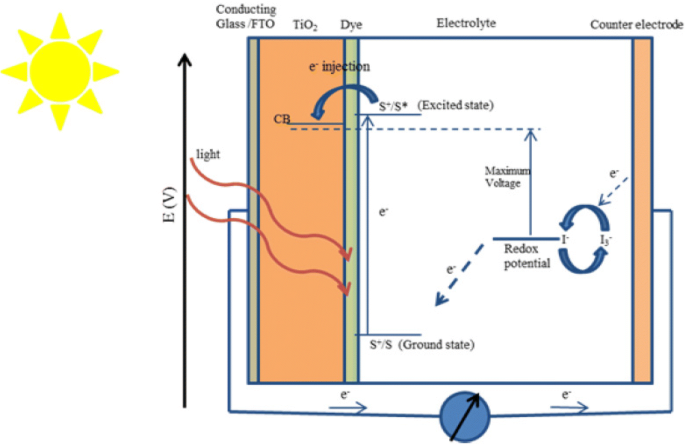
介绍
染料敏化太阳能电池 (DSSC) 已成为 p-n 结光伏器件的技术和经济可靠替代品。在 1960 年代后期,人们发现可以通过电化学电池中的有机染料发光来发电。在加州大学伯克利分校,从菠菜中提取叶绿素(光合作用)。第一个叶绿素敏化氧化锌 (ZnO) 电极于 1972 年合成。这是第一次通过将激发的染料分子电子注入半导体的宽带隙中,将光子转化为电能 [1]。对 ZnO 单晶进行了大量研究 [2],但这些染料敏化太阳能电池的效率非常差,因为单层染料分子只能吸收高达 1% 的入射光。因此,通过优化由细氧化物粉末组成的电极的孔隙率来提高效率,从而可以增强电极上染料的吸收,从而也可以增强光收集效率(LHE)。结果,发现了粗糙度系数约为 1000 的纳米多孔二氧化钛 (TiO2) 电极,并于 1991 年发明了效率为 7% 的 DSSC [3]。这些细胞,也称为 Grätzel 细胞,最初由加州大学伯克利分校的 Brian O'Regan 和 Michael Grätzel 于 1988 年共同发明 [3],并由上述洛桑联邦理工学院 (EPFL) 的科学家进一步开发,直到 1991 年。
布赖恩·奥雷根 (Brian O'Regan) 和迈克尔·格雷泽尔 (Michael Grätzel) 制造了一种基于 10 微米厚、高表面积和光学透明的二氧化钛纳米粒子薄膜的装置,该薄膜涂有单层电荷转移染料,具有理想的光谱特性,使薄膜敏感以进行光收集.该设备收集了 46% 的高比例入射太阳能通量,并显示出异常高的效率,将入射光子转换为电流的效率甚至超过 80%。模拟太阳光下的总入射光子电流转换效率 (IPCE) 产率为 7.1-7.9%,漫射日光下为 12%。大短路电流密度J SC(大于 12 mAcm − 2 ) 和出色的稳定性(持续至少 500 万次周转而不分解)和低成本使实际应用变得可行 [3]。 1993 年,Grätzel 等人。报道了 9.6% 的电池效率,然后在 1997 年,他们在国家可再生能源实验室 (NREL) 达到了 10%。敏化剂通常设计为具有官能团,例如–COOH、–PO3H2 和–B(OH)2,以便稳定吸附到半导体基材上 [4, 5]。最近在 2018 年,Costa 等人报道了基于混合染料-二氧化钛纳米颗粒的 DSSC 的效率为 8.75%,以实现优异的低温。 [6]。在传统的太阳能电池中,Si 提供两种功能:充当光电子源并提供电场以分离电荷并产生电流。但是,在 DSSC 中,大部分半导体仅用作电荷传输器,光电子由光敏染料提供。 DSSC 的理论预测功率转换效率 (PCE) 约为 20% [7, 8];因此,多年来对 DSSC 进行了广泛的研究,以提高效率并促进其商业化。然而,在过去的几十年里,进行了大量的实验来提高 DSSC 的性能。例如,如果查看 1920 年和 1921 年左右发表的评论文章或论文,可能会发现这些电池在性能和制造方面存在显着差异。很少有评论论文与各自文章中显示的客观和主要结果讨论,以了解这些细胞的性能如何得到改善,从而DSSCs如何成为研究人员的热门话题。
Anandan 回顾了直到 2007 年染料敏化太阳能电池的改进和出现的挑战 [9]。他的综述研究的主要组成部分是光收集无机染料分子、p-CuO 纳米棒反电极和电活性聚合物的自组织,他展示了这些材料在合理设计的太阳能电池中的表现。然而,萘啶配位Ru络合物的综述论文中讨论了7%的最大IPCE[10],该论文在2007年之前表现良好,但几乎是后来工作中显示的效率的一半。
Bose 等人发表的评论论文的主要重点。 [11] 是截至 2015 年 DSSC 的光电极、光敏剂和电解质领域的现状和发展。他们包括一项有趣的研究,通过显示的图表比较 DSSC 模块与 Si 基模块的性能在图 1 [12] 中得出结论,DSSC 模块的性能远优于 Si 模块。此外,本文讨论的最高效率是 N719 染料基 DSSC 的 11.2%。
<图片>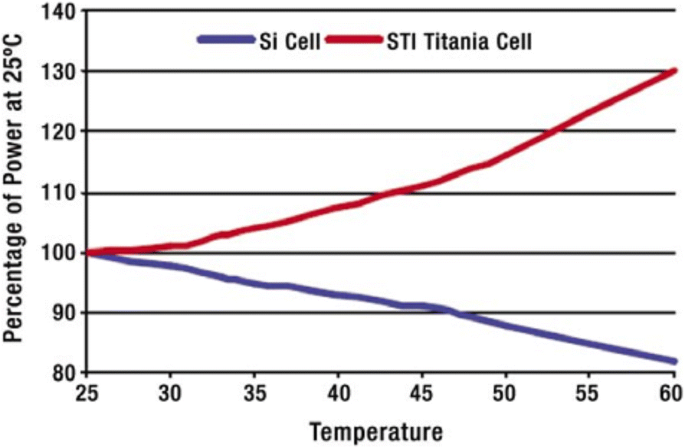
与基于硅的模块相反,染料 PV 模块的性能随温度而增加 [(网络参考 [可在线访问 http://www.sta.com.au/downloads/DSC%20Booklet.pdf] [11, 12]
沙里尼等人。 [13] 强调了敏化剂,包括钌配合物、无金属有机染料、量子点敏化剂、钙钛矿基敏化剂、媒染染料和天然染料。然而,本文提供了有关不同类型敏化剂的大量知识,但缺乏有关 DSSC 其他重要组成部分的信息。同样,除了讨论 DSSC 的所有不同组成部分外,Jihuai Wu 等人的评论文章。 [14] 集中在对电极部分。他们讨论了基于透明度和柔韧性、金属和合金、碳材料、导电聚合物、过渡金属化合物和杂化物的不同类型对电极的研究。讨论了以 Au/GNP 作为对电极 Co 3+/2+ 制造的 DSSC 的最高效率为 14.3% 作为氧化还原对,LEG4 + ADEKA-1 作为敏化剂 [15] 并在评论文章中显示。同样,Yeoh 等人。和范等人。 [16, 17] 对 DSSC 的光电阳极进行了简要回顾。他们将光阳极的改性分为三类,即通过引入阻挡和散射层进行界面改性、复合、掺杂非金属阴离子和金属阳离子、界面工程以及用 1- D或二维纳米结构。
因此,通过比较之前发表的不同评论文章,不难看出,本篇评论文章“染料敏化太阳能电池:基础和现状”深入研究了不同组件及其在 DSSC 中的应用以及构建和这些细胞的工作。
DSSC 的构建和工作
工作电极、敏化剂(染料)、氧化还原介质(电解质)和对电极是 DSSC 的四个关键参数。 DSSC是用敏化剂或染料浸泡的工作电极组件,并借助热熔胶带密封到浸泡了薄薄一层电解液的对电极上,以防止电解液泄漏(如图2所示) . DSSC的组成以及结构和工作如下所示:
<图片>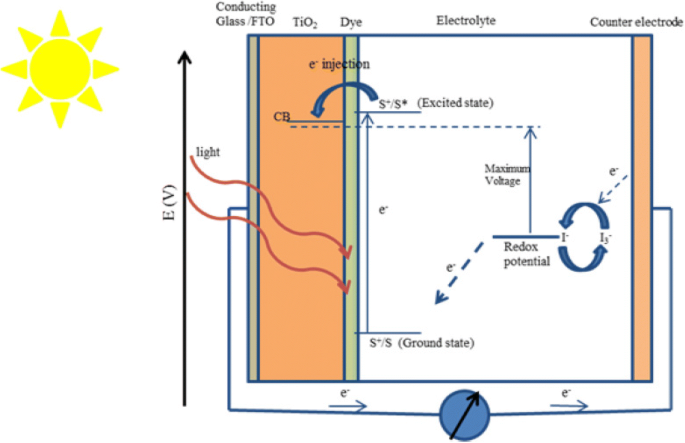
染料敏化纳米晶太阳能电池的构建及工作原理
透明导电基材
DSSC 通常由两片导电透明材料构成,这有助于基板沉积半导体和催化剂,同时也充当集电器 [18, 19] DSSC 中使用的基板有两个主要特征:首先,基板需要超过 80% 的透明度,以允许最佳阳光通过到电池的有效区域。其次,为了在 DSSC 中进行有效的电荷转移和减少能量损失,它应该具有高导电性。掺氟氧化锡 (FTO, SnO2:F) 和掺铟氧化锡 (ITO, In2O3:Sn) 通常用作 DSSC 中的导电基材。这些基板由钠钙玻璃组成,该玻璃涂有掺铟氧化锡和掺氟氧化锡层。 ITO 薄膜的透射率> 80% 和 18Ω/cm 2 的薄层电阻,而 FTO 薄膜在可见光区的透射率较低,为 ~ 75%,薄层电阻为 8.5Ω/cm 2 [18].
工作电极 (WE)
工作电极 (WE) 是通过在由 FTO 或 ITO 制成的透明导电玻璃板上沉积一层薄薄的氧化物半导体材料来制备的,例如 TiO2、Nb2O5、ZnO、SnO2(n 型)和 NiO(p 型) .这些氧化物具有 3-3.2 eV 的宽能带隙。与金红石形式相比,锐钛矿同素异形形式的 TiO2 在 DSSC 中的应用更值得称道,因为其更高的能带隙为 3.2 eV,而金红石形式的带隙约为 3 eV [20, 21] ZnO 和 Nb2O5 等宽带隙氧化物也取得了可喜的成果 [22, 23]。由于无毒、便宜且易于获得,TiO2 主要用作半导体层。然而,这些半导体层仅吸收紫外线区域的一小部分光;因此,然后将这些工作电极浸入光敏分子敏化剂和溶剂的混合物中。将薄膜浸入染料溶液中后,染料与 TiO2 表面共价结合。由于电极的高度多孔结构和大表面积,大量染料分子附着在纳米晶TiO2表面,从而增加了半导体表面的光吸收。
光敏剂或染料
染料是 DSSC 的组成部分,负责最大程度地吸收入射光。任何被染色的材料都应具有以下光物理和电化学特性:
- 1.
首先,染料应该是发光的。
- 2.
其次,染料的吸收光谱应覆盖紫外-可见(UV-vis)和近红外(NIR)区域。
- 3.
最高占据分子轨道 (HOMO) 应远离 TiO2 导带表面,最低未占分子轨道 (LUMO) 应尽可能靠近 TiO2 表面,随后应高于TiO2导带电位。
- 4.
HOMO 应低于氧化还原电解质。
- 5.
染料的外围应该是疏水的,以提高电池的长期稳定性,因为它可以最大限度地减少电解质和阳极之间的直接接触;否则,TiO2 表面会出现染料的水致畸变,从而降低细胞的稳定性。
- 6.
为了避免染料在 TiO2 表面聚集,将鹅脱氧胆酸 (CDCA) 等辅助吸收剂和烷氧基甲硅烷基 [24]、磷酸 [25] 和羧酸基团 [26, 27] 等锚定基团插入染料和二氧化钛。这会阻止染料聚集,从而限制氧化还原电解质与 TiO2 纳米层中电子之间的复合反应 [28],并导致形成稳定的键。
电解质
一种电解质(例如 I − /I − 3、Br − /Br − 2 [29], SCN − /SCN2 [30] 和 Co(II)/Co(III) [31]) 有五个主要成分,即氧化还原对、溶剂、添加剂、离子液体和阳离子。电解质应具有以下特性:
- 1.
氧化还原对应该能够有效地再生氧化染料。
- 2.
应具有长期的化学、热和电化学稳定性。
- 3.
对 DSSC 组件应无腐蚀性。
- 4.
应该能够允许电荷载流子快速扩散,提高电导率,并在工作电极和对电极之间建立有效的接触。
- 5.
电解质的吸收光谱不应与染料的吸收光谱重叠。
我 - /I − 3 已被证明是一种高效的电解质 [32],但其在 DSSC 中的应用存在一定的局限性。我 - /I − 3 电解液腐蚀玻璃/TiO2/Pt;它是高度挥发性的,负责光降解和染料解吸,并且长期稳定性差 [33, 34]。乙腈 (ACN), N -甲基吡咯烷 (NMP) 和溶剂混合物,例如 ACN/戊腈,已被用作具有高介电常数的溶剂。 4-叔丁基吡啶 (TBP) 主要用作添加剂使 TiO2 的导带向上移动,导致开路电压值 (V OC),降低电池光电流 (J SC),注射驱动力较小。据信,TiO2 表面上的 TBP 通过向电解质的反向转移减少了复合 [35]。然而,与离子液体相关的最大缺点是它们的泄漏系数。因此,开发固态电解质是为了避免与离子液体 (IL) 电解质相关的缺点 [36]。此外,为了测试氧化还原电解液的失效或长期光照下的密封,密封电池的长期光浸泡试验也取得了显着进展[37]。
反电极 (CE)
DSSC 中的 CE 主要是使用铂 (Pt) 或碳 (C) 制备的。工作电极和对电极都密封在一起,然后在注射器的帮助下填充电解质。对电极催化I − 的还原 /I − 3 液体电解质并从空穴传输材料 (HTM) 中收集空穴。 Pt 主要用作对电极,因为它表现出更高的效率 [38],但由于其成本较高且丰度较低,因此非常需要替代 Pt。因此,已经开发出几种替代品来替代 DSSC 中的 Pt,例如碳 [39]、硫化羰 (CoS) [40]、Au/GNP [15]、合金 CE,如 FeSe [41] 和 CoNi0.25 [42],尽管 Jihuai Wu 等人也讨论了不同类型的 CE。 [14].
工作原理
DSSC的工作原理包括四个基本步骤:光吸收、电子注入、载流子传输和电流收集。光子到电流的转换涉及以下步骤(如图2所示):
- 1.
首先,入射光(光子)被光敏剂吸收,因此,由于光子吸收,电子从基态(S + /S) 到激发态 (S + /S*) 染料,其中大部分染料的吸收在 700 nm 范围内,这对应于几乎约 1.72 eV 的光子能量。
- 2.
现在,寿命为纳秒范围的激发电子被注入纳米多孔 TiO2 电极的导带中,该电极位于染料激发态以下,其中 TiO2 吸收来自 UV 区域的一小部分太阳光子 [43]。结果,染料被氧化。
$$ {\mathrm{S}}^{+}/\mathrm{S}+\mathrm{h}\upnu \rightarrow {\mathrm{S}}^{+}/{\mathrm{S}}^{ \ast } $$$$ {\mathrm{S}}^{+}/{\mathrm{S}}^{\ast}\rightarrow {\mathrm{S}}^{+}/\mathrm{S} +{\mathrm{e}}^{-}\\left({\mathrm{TiO}}_2\right) $$ - 3.
这些注入的电子在 TiO2 纳米粒子之间传输并向后接触(透明导电氧化物 [TCO])扩散。电子通过外电路到达对电极。
- 4.
对电极处的电子减少 I − 3 到 I − ;因此,染料再生或染料基态的再生是由于接受来自 I - 的电子而发生的 离子氧化还原介体,I − 被氧化成 I − 3(氧化态)。
$$ {\mathrm{S}}^{+}/{\mathrm{S}}^{\ast }+{\mathrm{e}}^{-}\rightarrow {\mathrm{S}}^{+ }/\mathrm{S} $$ - 5.
同样,氧化介体 (I − 3) 向对电极扩散并还原为 I 离子。
$$ {{\mathrm{I}}^{-}}_3+{2\mathrm{e}}^{-}\rightarrow {3\mathrm{I}}^{-} $$
染料敏化太阳能电池性能评估
染料敏化太阳能电池的性能可以通过入射光子电流转换效率(IPCE,%)、短路电流(J SC, mAcm − 2 ), 开路电压 (V 超频,V ), 最大输出功率 [P max],总效率[η , %] 和填充因子 [FF](如图 3 所示)在恒定光级曝光下,如方程式 1 所示。 1 [44]。
<图片>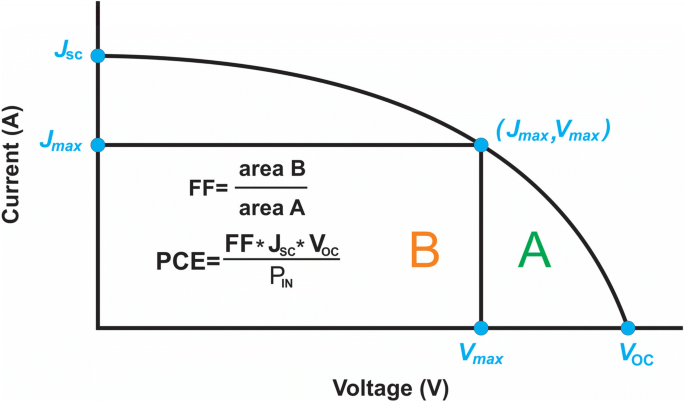
I-V 电池性能评价曲线
当电池的负极和正极在零 mV 电压下短路时会产生电流。 V 超频 (V ) 是在零毫安 (mA) 电流下开路条件下负极和正极之间的电压,或者简单地说,是半导体材料的导带能量与电解质的氧化还原电位之间的电位差。 P max 是 DSSC 将阳光转化为电能的最大效率。最大输出功率比(J mp × V mp) 到产品 (V OC × J SC) 给出 FF。
$$ \mathrm{FF}=\frac{\mathrm{Area}\ A}{\mathrm{Area}\ B}=\frac{J_{\mathrm{mp}}\times {V}_{\mathrm{ mp}}}{J_{SC}\times {V}_{OC}} $$此外,总效率 (%) 是太阳能(照射在光伏 [PV] 设备上)转化为电能的百分比,其中 ɳ 随着J值的减小而增加 SC 和 V 值的增加 分别为OC、FF和染料摩尔系数。
$$ \eta\ \left(\%\right)=\frac{J_{\mathrm{SC}}\times {V}_{\mathrm{OC}}\times \mathrm{FF}}{P_{in }} $$ (1)外量子效率(也称为IPCE)是任何波长λ流经外电路的电子数与入射到细胞表面的光子数之比 .给出如下:
$$ \mathrm{IPCE}\%\left(\lambda \right)=1240\times \frac{J_{\mathrm{SC}}}{P_{in}\lambda } $$ (2)IPCE 值还与 LHE、φE1 和 ηEC 相关。如方程式所示。 3 [45],
$$ \mathrm{IPCE}\ \left(\lambda, \mathrm{nm}\right)=\mathrm{LHE}\upvarphi \mathrm{E}1\upeta \mathrm{E}\mathrm{C} $$ (3)其中LHE为光收集效率,φE1为电子注入量子效率,ηEC为外电路收集电子的效率。
设备限制
近年来,DSSC 的效率已得到证明,但由于与这些电池相关的一些限制,它们仍需要进一步修改。在限制方面,稳定性失效可以分为两种不同的类别:(i)对外在稳定性的限制和(ii)对内在稳定性的限制。此外,由于氧化染料和电解质之间的能量不匹配,氧化染料在再生过程中会发生大量的能量损失。因此,为了提高这些电池的功效,开发了不同的电解质。格雷泽尔等人。显示超过 900 mV 的开路电压和短路电流 I 通过将空穴导体矩阵与 TBP 和 Li[CF3SO2]2N 的组合混合,SC 高达 5.1 mA,在空气质量 1.5 (AM 1.5) 照明下产生 2.56% 的总效率 [46]。此外,FTO 玻璃板的薄层电阻约为 10 Ω/sq.;因此,这使得器件的缩放变得困难,并成为有效单元面积> 1 cm 2 的限制因素 .因此,为了增加薄层电阻并保持工作电极和对电极之间的间距,太阳能电池需要短路或者间距应该增加 25 到 50 μm [47] 在小模块中(这些模块由活动细胞区域的小条纹 (1 cm 2 ) 与相邻的银线 [47, 48])。因此,对于 1-cm 2 ,IPCE 值从 10.4% 下降到 6.3% 观察到 26.5 cm 2 子模块的电池 [49].
为了提升电池性能,可以使用银手指收集电流并使用热熔胶带等密封材料,以防止电解液泄漏。尽管由于电解液的化学腐蚀性,使用银手指不太可行。并且由于模块较小,泄漏的机会增加,导致有效单元面积减少 32% [47]。另一个因素是影响 DSSC 性能的玻璃板的导电性。因此,可以通过将掺铟氧化锡(ITO,高导电但化学稳定性较差)和掺氟氧化锡(FTO,高度化学稳定但导电性较差)结合在一起来提高透明导电氧化物 (TCO) 的导电性.这导致 TCO 玻璃的薄层电阻降低至 1.3 Ω/sq。 [50].
对设备稳定性的限制
DSSCs 需要在外在和内在稳定,以便与硅太阳能电池相媲美,以满足市场需求,从而提高其商业化程度。稳定性的局限性讨论如下:
限制外在稳定性(密封胶材料的稳定性)
在 DSSC 中使用 Surlyn® 和 Bynel® 热熔箔等密封剂材料来密封电池 [48]。当电池内部的压力增加时,它们的密封能力会降低 [51],并且如果暴露在循环或有规律的温度变化中 [52]。但由于其成本低且易于加工,因此不能忽视它们的利用。因此,需要通过用金属氧化物颗粒对玻璃进行预处理来增加它们与玻璃的粘合性。作为替代方案,还开发了基于低熔点玻璃料 [53] 的密封胶,其比热熔箔具有更高的稳定性,但这些密封胶不适用于大面积模块生产。
内在稳定性的限制
为了检查电池的内在稳定性,进行了加速老化实验。这些加速老化实验持续 1000 小时,以显示染料、电解质和 Pt 对电极在 80°C 温度下的热稳定性。通过这些实验,发现小型测试电池在升高的温度下可以保持 90% 的初始效率,观察到的初始效率分别为 7.65% [54] 和 8% [55]。此外,在 AM 1.5 和 55-60°C 中等温度下,该设备可稳定运行 1000 小时。但是,当压力因素(即约 80°C 的温度和光浸泡)结合在一起时,观察到电池性能会迅速下降 [52]。因此,需要提高电池的内在稳定性,因为在晴天很容易达到 80°C 的温度。
提高 DSSC 效率的不同方法
为了提高 DSSC 的效率和稳定性,研究人员必须关注基本的制造方法和材料,以及这些电池的工作。下面讨论了提高这些太阳能电池 (SC) 效率的不同方法:
- 1.
为了提高 DSSC 的效率,必须在电子注入后将氧化的染料牢固地还原到其原始基态。换句话说,与染料氧化过程[重组过程(0.1 到 30 μs)] 相比,再生过程(发生在纳秒范围内 [56])应该更快。作为氧化还原介质电位 (I − ion) 强烈影响最大光电压,因此氧化还原对的电位应接近染料的基态。为了执行这个可行的重复过程,需要大约 210 mV 的驱动力(或大约 0.6 伏 [56])。
- 2.
通过增加TiO2纳米颗粒的孔隙率,在WE处发生最大染料吸收。
- 3.
通过在导电玻璃板上沉积 TiO2 纳米颗粒的均匀薄层或下层来减少或阻止暗电流的形成。因此,电解质不与FTO直接接触或背接触,因此不会被集电极电子还原,从而限制了暗电流的形成。
- 4.
防止纳米多孔 TiO2 纳米粒子被 TBP 分子或电解质溶剂捕获。因此,需要通过敏化剂对 WE 进行均匀敏化。如果纳米多孔TiO2电极的整个表面没有被敏化剂均匀覆盖,则纳米多孔TiO2的裸点可以被TBP分子或电解质溶剂捕获。
- 5.
共敏化是另一种优化 DSSC 性能的方法。在共增感中,两种或多种具有不同吸收光谱范围的增感染料混合在一起。拓宽光谱响应范围[57]。
- 6.
通过促进使用不同材料制造电极,如纳米管、碳纳米线、石墨烯;使用多种电解质代替凝胶电解质和准固体电解质等液体电解质;对工作电极提供不同的后处理,如阳极氧化预处理和TiCl4处理;使用不同类型的CEs [14] 并通过开发疏水敏化剂,可以极大地提高这些细胞的性能和效率。
- 7.
通过插入磷光或发光发色团,例如将稀土掺杂的氧化物应用到 DSSC [58,59,60],在光电阳极的玻璃上涂覆发光层 [60,61,62],即使用等离子体现象[ 63] 并在电解质中添加能量中继染料 (ERDs) [57, 64, 65]。
DSSC 的先前和进一步改进
为了以更高的效率制造低成本、更灵活、更稳定的 DSSC,需要重量轻、薄、成本低且易于合成的新材料。因此,本节包括 DSSC 领域的先前和进一步改进。本部分简要介绍了不同研究人员在过去 10-12 年中所做的工作以及他们对各自细胞的观察结果。
工作和反电极
Grätzel 和他的同事在 DSSC 的性能方面表现出了巨大的进步。他们使用具有纳米多孔结构和大表面积的纳米晶 (nc) TiO2 薄膜电极在 AM 1.5 辐照下证明了 7-10% 的效率,并在 EPFL 使用新型 Ru 联吡啶配合物作为敏化剂和离子氧化还原电解质 [3, 26]。 TiO2电极的导带能级和I − 的氧化还原电位 /I − 3 作为 - 0.7 V 相对于饱和甘汞电极 (SCE) 和 0.2 V 相对于 SCE 已被评估 [66, 67]。 2014 年展示了一种以咖啡为天然染料的二元氧化物光电极 [68]。 SnO2 (x )–ZnO (1 − x ) binary system with two different SnO2 composition (x = 3, 5 mol%) were prepared by solid-state reaction at high temperature and employed as a photoanode. An improved efficiency was demonstrated for the larger SnO2 composition and an overall power conversion efficiency (PCE) observed for SnO2:ZnO device was increased from 0.18% (3:97 mol%) to 0.26% for a device with SnO2:ZnO (5:95 mol%) photoanode.胡等人。 observed that the performance of the DSSCs with graphite-P25 composites as photoanodes has been significantly enhanced by 30% improvement of conversion efficiency compared with P25 alone. They found an enhancement in the value of J SC from 9.03 to 12.59 mA/cm 2 under the condition of 0.01 wt% graphite amount and attained the conversion efficiency of 5.76% [69]. Figure 4 shows the SEM images of the photoanodes. Apart from TiO2, carbon and its different allotropes are also widely applied in DSSCs to fulfill future demand and arisen as a perfect surrogate material for DSSCs. Some reports have shown that incorporating carbon nanotube (CNT) in TiO2 by hydrothermal or sol–gel methods greatly improved the cell’s performance [70,71,72]. Also, by improving the interconnectivity between the TiO2 and CNT, an increase in the IPCE can be found [70].孙等人。 reported that the DSSCs incorporating graphene in TiO2 photoanode showed a PCE of 4.28%, which was 59% higher than that without graphene [73].夏尔马等人。 has shown the improvement in the PCE value from 7.35 to 8.15% of the co-sensitized solar cell using modified TiO2 (G-TiO2) photoanode, instead of pure TiO2 photoanode [74]. In 2014, it was shown that the electronically and catalytically functional carbon cloth works as a permeable and flexible counter electrode for DSSC [75]. The researchers have found that the TiN nanotube arrays and TiN nanoparticles supported on carbon nanotubes showed high electrocatalytic activity for the reduction of triiodide ions in DSSCs [76, 77]. Single-crystal CoSe2 nanorods were applied as an efficient electrocatalyst for DSSCs by Sun et al. in 2014 [78]. They prepared single-crystal CoSe2 nanorods with a facile one step hydrothermal method. By drop-casting the CoSe2 nanorod suspension onto conductive substrates followed by simple drying without sintering, they fabricated the thin CoSe2 films and used as a highly efficient electrocatalyst for the reduction of I − 3. They showed a power conversion efficiency of 10.20% under AM1.5G one-sun illumination for DSSCs with the standard N719 dye.帕克等人。 prepared a mesoporous TiO2 Bragg stack templated by graft copolymer for dye-sensitized solar cells [79]. To enhance dye loading, electron transport, light harvesting and electrolyte pore-infiltration in DSSCs, they prepared organized mesoporous TiO2 Bragg stacks (om-TiO2 BS) consisting of alternating high and low refractive index organized mesoporous TiO2 (om-TiO2) films. They synthesized om-TiO2 films through sol-gel reaction using amphiphilic graft copolymers consisting of poly(vinyl chloride) backbones and poly(oxyethylene methacrylate) side chains, i.e., PVC-g -POEM as templates. They showed that a polymerized ionic liquid (PIL)-based DSSC fabricated with a 1.2-μm-thick om-TiO2 BS-based photoanode exhibited an efficiency of 4.3%, which was much higher than that of conventional DSSCs with a nanocrystalline TiO2 layer (nc-TiO2 layer) with an efficiency of 1.7%. An excellent efficiency of 7.5% was demonstrated for a polymerized ionic liquid (PIL)-based DSSC with a heterostructured photoanode consisting of 400-nm-thick organized mesoporous TiO2 interfacial (om-TiO2 IF) layer, 7-μm-thick nc-TiO2, and 1.2-μm-thick om-TiO2 BS as the bottom, middle, and top layers, respectively, which was again much higher than that of nanocrystalline TiO2 photoanode with an efficiency of 3.5%.李等人。 reported platinum-free, low-cost, and flexible DSSCs using graphene film coated with a conducting polymer as a counter electrode [80]. In 2014, Banerjee et al. demonstrated nickel cobalt sulfide nanoneedle-array as an effective alternative to Pt as a counter electrode in dye-sensitized solar cells [81].

a 的 SEM 图像 P25 film, b 1 wt% graphite-P25 composite film, and (c ) the cross section of P25 film on FTO [69]
Calogero et al. invented a transparent and low-cost counter electrode based on platinum nanoparticles prepared by a bottom-up synthetic approach. They demonstrated that with such a type of cathode, the observed solar energy conversion efficiency was the same as that obtained for a platinum-sputtered counter electrode and even was more than 50% obtained with a standard electrode, i.e., one prepared by chlorine platinum acid thermal decomposition, in similar working condition [82]. By using a special back-reflecting layer of silver, they improved upon the performance of a counter electrode based on platinum sputtering and achieved an overall η of 4.75% under 100 mWcm − 2 (AM 1.5) of simulated sunlight. They showed that, for the optical transmittance at different wavelengths of platinum-based films, i.e., Pt nanoparticles, Pt thermal decomposition, and Pt sputtered deposited onto FTO glass, the platinum nanoparticle-based cathode electrode (CE) prepared by Pt sputtering deposition method appeared more transparent than the platinum CE prepared using the Pt acid thermal decomposition method. Meanwhile, when Pt nanoparticle deposition method was employed, the transmittance was very poor (as shown in Fig. 5). Anothumakkool et al. showed a highly conducting 1-D aligned polyethylenedioxythiophene (PEDOT) along the inner and outer surfaces of a hollow carbon nanofiber (CNF), as a counter electrode in a DSSC to enhance the electrocatalytic activity of the cell [83]. They showed that the hybrid material (CP-25) displayed a conversion efficiency of 7.16% compared to 7.30% for the standard Pt counter electrode, 4.48% for bulk PEDOT and 5.56% for CNF, respectively. The enhanced conversion efficiency of CP-25 was accredited to the accomplishment of high conductivity and surface area of PEDOT through the 1-D alignment compared to its bulk counterpart. Further, through a long-term stability test involving efficiency profiling for 20 days, it was observed that CP-25 exhibited extraordinary durability compared to the bulk PEDOT. Recently, Huang et al. improved the performance of the device by inserting a H3PW12O40 layer between the transparent conductive oxide layer and the compact TiO2 layer [84]. They observed the reduction in the recombination of the electrons upon the addition of H3PW12O40 layer, resulting in longer electron lifetime and obtained a η = 9.3%, respectively.
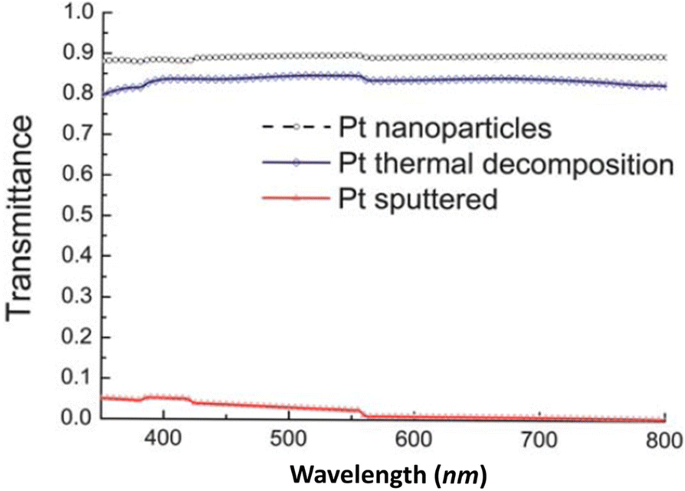
Optical transmittance of platinum-based films (Pt nanoparticles, Pt thermal decomposition, Pt sputtered) deposited onto FTO glass [82]
李等人。 reported that the transition metal nitrides MoN, WN, and Fe2N show Pt-like electrocatalytic activity for dye-sensitized solar cells, where MoN showed superior electrocatalytic activity and a higher PV performance [85]. Characteristic J–V curves of DSSCs using different metal nitrides and Pt counter electrodes showed that the cell fabricated with the MoN counter electrode achieved a FF = 0.66, which was higher than that of the Pt electrode (as shown in Fig. 6). However, J SC = 11.55 mAcm − 2 was relatively high and the V OC of 0.735 V was almost same to the V OC = 0.740 V offered by Pt electrode. In the case of WN, V OC 和 J SC were relatively low, indicating a low efficiency of 3.67%. DSSC with the Fe2N electrode attained lower values of V OC and FF, i.e., 0.535 V of V OC and 0.41 of FF, resulting in a poor η = 2.65%. Thus, above data shows superior performance of MoN-based DSSC among all other metal nitrides as CE material. Gokhale et al. showed a laser-synthesized super-hydrophobic conducting carbon with broccoli-type morphology as a CE for dye-sensitized solar cells in 2012 [86]. In 2014, plasmonic light harvesting of dye-sensitized solar cells by Au nanoparticle-loaded TiO2 nanofibers was demonstrated by Naphade et al. [87] because the surface morphology of a WE and a CE play a key role in the performance of DSSC. Usually, mesoporous TiO2 nanoparticle films are used in WE fabrication because they provide large surface area for efficient dye adsorption. However, there are certain limitations associated with them as short electron diffusion length (10–35 μm) and random electrical pathway induced by the substantial trapping and detrapping phenomena that take place within excessive surface states, defects, and grain boundaries of nanoparticles [88] and disorganized stacking of TiO2 films which limits the electron transport [89]. Thus, doping of metallic cations and non-metallic anions in TiO2, treating FTOs [90], applying 1-D nanostructures like nanowires, nanorods, nanosheets, nanoplates [16], and hollow spheres are approaches to modify the WE. However due to the low surface area, these 1-D nanostructures show poor dye loading. In 2015, Zhao et al. studied the influence of the incorporation of CNT-G-TiO2 NPs into TiO2 NT arrays and attained an efficiency of 6.17% for the DSSC based on CNT-G-TiO2 nanoparticles/TiO2 nanotube double-layer structure photoanode [91]. An efficiency of 8.30% was demonstrated by Qiu et al. for the DSSC based on double-layered anatase TiO2 nanospindle photoanodes [92].
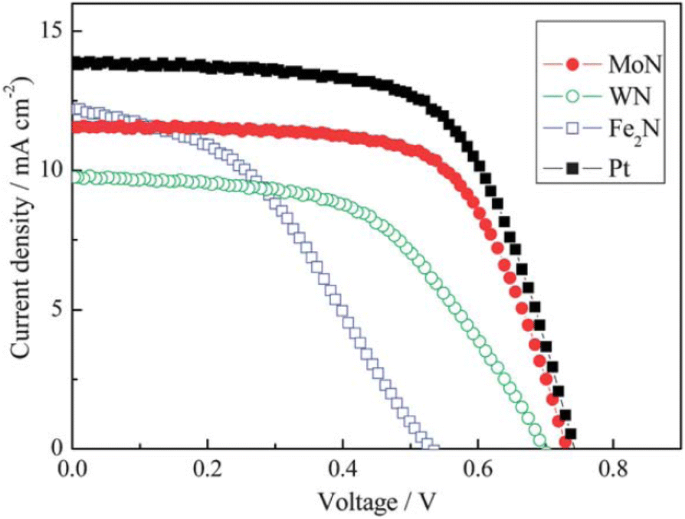
Characteristic J –V curves of DSSCs using different metal nitrides and Pt counter electrodes, measured under simulated sunlight at 100 mWcm − 2 (AM 1.5) [85]
Apart from NTs, bilayer TiO2 hollow spheres/TiO2 nanotube array-based DSSC also showed an effective efficiency of 6.90% [93]. Efficiency can also be improved by incorporating SnO2 as a shell material on a photoanode [94]. The integration of SnO2 as a shell material on ZnO nanoneedle arrays results in a larger surface area and reduced recombination rate [94], thus increasing the dye adsorption which plays a crucial role in the performance of a cell. Huang and co-workers synthesized mesoporous TiO2 spheres of high crystallinity and large surface area and applied it as a WE in the device. An excellent efficiency of 10.3% was achieved for the DSSC-employed TiO2 spheres with long-term stability due to the terrific dye-loading and light-scattering abilities as well as attenuated charge recombination. Further, the efficiency was improved by performing the TiCl4 treatment [95].
Maheswari et al. reported various DSSCs employing zirconia-doped TiO2 nanoparticle and nanowire composite photoanode film. They demonstrated highest η = 9.93% for Zirconia/TNPW photoanode with a hafnium oxide (HfO2) blocking layer and observed that the combination of zirconia-doped photoanode with blocking layer possibly restrains the recombination process and increases the PCE of the DSSCs effectively [96]. However, many ideas do not achieve a great efficiency initially but at least embed different ideas and aspects for the synthesis of new materials. For instance, by using carbon-coated stainless steel as a CE for DSSC, Shejale et al. demonstrated a η = 1.98%, respectively [97]. Recently in 2018, a study was carried out to determine the effect of microwave exposure on photoanode and found an enhancement in the efficiency of the cell upon exposure. For the preparation of the DSSC, a LiI electrolyte, Pt cathode, TiO2 photoanode, and Alizarin red as a natural sensitizer were used. An efficiency of 0.144% was found for the cell, where 10 min of microwave exposure was carried upon the photoanode [98].
Similarly, varied materials as mentioned earlier are synthesized as CE for efficient DSSCs. Last year, Guo et al. synthesized an In2.77S4@conductive carbon (In2.77S4@CC) hybrid CE via a two-step method and achieved η = 8.71% for the DSSC with superior electrocatalytic activity for the reduction of triiodide and, also, comparable to the commercial Pt-based DSSC that showed PCE of 8.75%, respectively [99]. The doping of an organic acid, 1S-(+)-camphorsulfonic acid, with the conductive polymer poly(o-methoxyaniline) to form a hybrid (CSA/POMA) and its application in DSSCs as CE has been examined by Tsai et al. This CE showed increased surface roughness, decreased impedance, and increased crystallinity [100]. In 2017, Liu et al. fabricated DSSCs employing Co(bpy)3 3+/2+ as the redox couple and carbon black (CB) as the CE [101]. The observation revealed superior electrocatalytic activity of a well-prepared CB film compared to that of conventional sputtered Pt. Due to the flexible nature of Cu foil substrates, Cu2O has also been employed as a CE in DSSC [102]. The fabrication of different samples by varying the sintering temperature of the CEs and obtaining the maximum efficiency of 3.62% at 600 °C of temperature has been reported [102]. Figure 7 shows the I –V characteristics and IPCE curves of DSSCs employing different Cu2O CEs. In 2013, by replacing the FTO with Mo as the conductor for the counter electrode, an increase in the value of FF as well as η was found [103]. The EIS Nyquist plots (as shown in Fig. 8) showed the difference in R s between the devices employed FTO (15.11 Ωcm 2 ) and Mo (7.25 Ωcm 2 ) due to the dissimilarity of the sheet resistance between FTO (8.2 Ω/sq) and Mo (0.16 Ω/sq). Also, by replacing FTO with Mo, a decrease in the R ct1 value from 6.87 to 3.14 Ωcm 2 was induced by the higher redox reactivity of Pt on Mo than that on FTO. In the queue of developing new materials, Maiaugree et al. fabricated DSSCs employing carbonized mangosteen peel (MPC) as a natural counter electrode with a mangosteen peel dye as a sensitizer [104]. They observed a typical mesoporous honeycomb-like carbon structure with a rough nanoscale surface in carbonized mangosteen peels and achieved the highest value of η = 2.63%. By analyzing the Raman spectra (shown in Fig. 9), they found a broad D-peak (130.6 cm − 1 of FWHM) located at 1350 cm − 1 indicating the high disorder of sp3 carbon and a narrower G peak (68.8 cm − 1 of FWHM) at 1595 cm − 1 which correlated with a graphite oxide phase observed in 2008 [105]. Thus, it was concluded the graphite oxide from MPC was a highly ordered sp2 hexagonal carbon oxide network. Furthermore, I–V characteristics of DSSCs employing different WE and CE are summarized in Table 1.
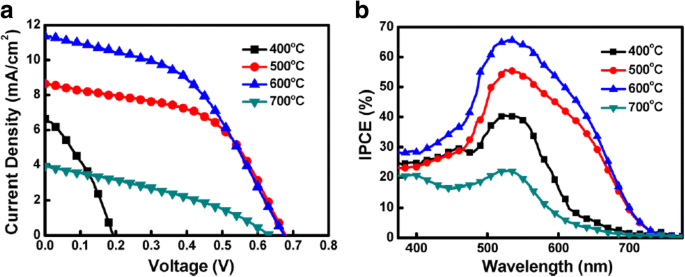
a current density–voltage (J –V ) 和 b incident monochromatic photon-to-current conversion efficiency (IPCE) curves of DSSCs using various Cu2O CE [102]
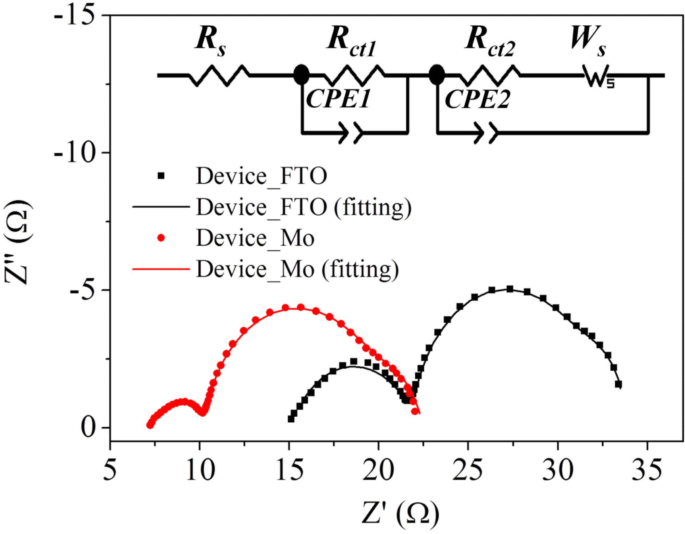
Nyquist plots of the Device_FTO and Device_Mo. The inset indicates an equivalent circuit model used for the devices [103]
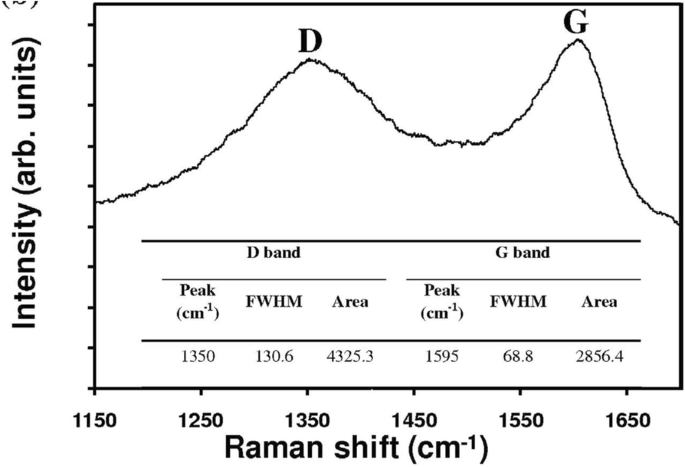
Raman spectra of mangosteen peel carbon [104]
Electrolyte
To improve and study the performance of DSSCs, different electrolytes like gel electrolytes, quasi-solid-state electrolytes, ionic liquid electrolytes etc. have been applied as mediators so far. However, a different trend to optimize the performance of the DSSCs has been initiated by adding the energy relay dyes to the electrolyte.
Liquid Electrolyte
The cells efficiency through liquid electrolyte can be augmented by introducing iodide/triiodide redox couple and high dielectric constant organic solvents like ACN, 3-methoxypropionitrile (MePN), propylene carbonate (PC), γ-butyrolactone (GBL), N -methyl-2-pyrrolidone (NMP), ethylene carbonate (EC), and counter ions of iodides, where solvents are the key component of a liquid electrolyte. On the basis of their stability, organic solvents can be sequenced as imidazolium
As low-viscous solution can cause leakage in the cell, thus, application of solidified electrolytes obtained by in situ polymerization of precursor solution containing monomer or oligomer and the iodide/iodine redox couple results in a completely filled quasi-solid-state electrolyte within the TiO2 network with negligible vapor pressure [107]. Komiya et al. obtained initial efficiency of 8.1% by applying the aforementioned approach [107]. But still a question arises whether the polymer matrix will degrade under prolonged UV radiations or not. The effect on the addition of SiO2 nanoparticles to solidify the solvent was also studied as to increase the cell efficiency [108], where only inorganic materials were applied in this technique. However, there are certain limitations associated with the addition of organic solvents within a liquid electrolyte, i.e., this leads hermetic sealing of the cell and the evaporation of solvents at higher temperature, and thus the cells do not uphold long-term stability. Therefore, more research was carried over the developments and implementation of gel, polymer, and solid-state electrolytes in the DSSCs with various approaches, such as the usages of the electrolytes containing p-type inorganic semiconductors [109], organic hole transporting materials (HTMs) [110], and polymer gelator (PG) [111].陈等人。 fabricated a solid-state DSSC using PVB-SPE (polyvinyl butyral-quasi-solid polymeric electrolyte) as an electrolyte. They measured the efficiency approximately 5.46%, which was approximately 94% compared to that of corresponding liquid-state devices, and the lifetime observed for the devices was over 3000 h [112]. Recently, a study explained the stability of the current characteristics of DSSCs in the second quadrant of the I–V characteristics [113]. The study explains the continuous flow of the forward current and the operating voltage point that gradually shift towards more negative voltages in the second quadrant of the I–V 特征。 The increase in the ratio of iodide to tri-iodide in the electrolyte rather than to the decomposition or the coupling reactions of the constituent materials was considered to be the reason behind it. According to the studies, these changes were also considered as reversible reactions that can be detected based on the changes in the color of the electrolyte or the I–V measurements.
However, ILs with lower viscosity and higher iodine concentration are needed as to increase J SC by increasing iodine mass transport. Laser transient measurements have been attempted and revealed that the high iodide concentration present in the pure ILs leads to a reductive quenching of the excited dye molecule [114]. Due to the low cost, thermal stability, and good conductivity of the conductive polymers based on polytiophenes and polypyrroles, they can be widely applied in DSSCs despite using ILs [115]. For the application point of view, the IL should have a high number of delocalized negative charge and counterions with a high chemical stability. Also, the derivatives of imidazolium salts are one of the best applicable in DSSCs. When 1-ethyl-3-methylimidazolium dicyanamide [EMIM] [DCA] with a viscosity of only 21 mPa s [116] was combined with 1-propyl-3-methylimidayolium iodide (PMII, volume ratio 1:1), an efficiency of 7.4% was observed and, after prolonged illumination, some degradation was also found. A cell with a binary IL of 1-ethyl-3-methylimidazolium tetracyanoborate in combination with PMII showed a stable efficiency of 7% that retained at least 90% of its initial efficiency after 1000 h at 80 °C in darkness and 1000 h at 60 °C, at AM 1.5 [117]. Moudam et al. studied the effect of water-based electrolytes in DSSC and demonstrated a highly efficient glass and printable flexible dye-sensitized solar cells upon application [118]. They used high concentrations of alkylamidazoliums to overcome the deleterious effect of water. The DSSCs employed pure water-based electrolyte and were tested under a simulated air mass 1.5 solar spectrum illumination at 100 mWcm − 2 and found the highest recorded efficiency of 3.45% and 6% for flexible and glass cells, respectively. An increase in the value of V OC from 0.38 to 0.72 V on the addition of TBP to the electrolyte has been observed [26]. Thus, to improve the efficiencies of DSSC, new materials were synthesized and applied in DSSCs. L-cysteine/L-cystine redox couple was employed in DSSC by Chen et al. which showed a comparable efficiency of 7.70%, as compared to the cell using I − /I3 − redox couple (8.10%) [119]. In 2016, Huang et al. studied the effect of liquid crystals (LCs) on the PCE of dye-sensitized solar cells. They observed that the addition of minute amounts of LC decreases the J SC because it reduces the electrochemical reaction rate between the counter electrode and an electrolyte. Also, it delays the degradation rates of the cell because of the interaction between cyano groups of the doped LCs and organic solvent in the liquid electrolyte [120]. Main components of different kinds of electrolytes are discussed below:
Pyridine Derivatives (Like 4-Tert-Butylpyridine [TBP], 2-Propylpyridine, N -Methylbenzimidazole [NMBI])
The improved efficiency for a DSSC can be achieved by adding about 0.5 M of pyridine derivative within the electrolyte, due to which an increase in the value of V OC occurs. This improved V OC can be attributed to the positive band edge movement and slightly affected charge recombination rate on the basis of intensity-modulated photovoltage spectroscopy (IMVS) [121]. The study showed that after the adsorption of pyridine ring on TiO2 surface, the pyridine ring induced electron density into the TiO2 creating a surface dipole. But, the band edge movement results in the slight decrease in J SC as compared to the untreated cell, due to the diminution in the driving force for electron injection [122]. Further, application of NMBI over TBP was studied in 2003, due to its long-term stability under elevated temperature [54].
Alkyl Phosphonic/Carboxylic Acids (Like Decylphosphonic Acid [DPA], Hexadecylmalonic Acid [HDMA])
An improved V OC with slight decrease in the J SC have been observed when DPA [54] and HDMA [123] were combined. This was due to the presence of self-assembled long alkyl chain on the surface of TiO2, which is responsible for the formation of densely packed hydrophobic monolayer and reduction in recombination rate too, as these long alkyl chains repel iodide from TiO2 surface.
Guanidinium Derivatives (GuSCN)
The addition of guanidium thiocyanate as a co-absorbent in an electrolyte results in enhanced V OC by ca. 120 mV with a downward shift in the conduction band by ca. 100 mV [124] at the same time due to the suppression in the recombination rate by a factor of 20 and a difference of 20 mV gained for V OC。 By limiting the downward shift in the conduction band, an improvement in the overall efficacy can be attained.
Solid-State Electrolyte (SSE)
The SSE falls in two subcategories:(1) where hole transport materials are used as a transport medium and (2) SSE containing iodide/triiodide redox couple as a transport medium. Both kinds of SSEs are discussed below:
Hole Transport Materials (HTMs)
HTMs fall in the category of solid-state electrolytes, where HTMs are used a medium. These materials have set a great milestone in DSSCs and effectively applicable in cells because iodine/iodide electrolytes are highly chemically aggressive by nature and corrodes other materials easily, mostly metals. Most of the HTMs are chemically less-aggressive inorganic solids, organic polymers, or p-conducting molecules, although the results are still unmatched with the one obtained for iodine/iodide redox electrolytes because of the following reasons:
- 1.
Due to their solid form, an incomplete penetration of solid HTMs within nanoporous TiO2-layer leads to poor electronic contact between HTMs and the dye. Thus, incomplete dye regeneration takes place.
- 2.
The high frequencies of charge recombination from TiO2 to HTMs.
- 3.
Due to the presence of organic hole conducting molecules, the series resistance of the cell increases due to the low hole mobility in the organic HTMs as compared to IL electrolytes.
- 4.
HTM results in a drop in V OC, as the recombination rate of electrons of CB with HTM becomes higher as compared to iodine/iodide redox electrolytes.
- 5.
Low intrinsic conductivities of HTMs.
Thus, researchers need to synthesize and focus on HTMs whose VB energy should be slightly above the energy of the oxidized dye, should not absorb light, and must be photochemically stable, so that they can keep a healthy contact with the dye. Among a number of HTMs, some of the HTMs are discussed below:
Inorganic CuI Salt
CuI halogens and pseudohalogens are two classes of inorganic CuI salts that can be applied as HTMs in a DSSC. Copper bromide (CuBr), copper iodide (CuI), and copper thiocyanate (CuSCN) are some copper-based compounds which work as a hole conductor and are more effective due to their good conductivity. Although CuSCN is one of the best pseudohalogen HTMs and despite its high hole mobility, its application results in high series resistance and does not support high current and also shows poor electronic contact between CuSCN and the dye, and poor pore filling due to their fast crystallization rates, which resulted in low η of < 4% for the corresponding solid-state DSSCs [125]. Thus, to reduce the high recombination rate of electrons, additional blocking layers of insulating materials like SiO2 or Al2O3 can be applied or coated around the TiO2 particles which enhance the V OC due to the suppressed recombination rate. With respect to halogens, CuBr showed an efficiency of 1.53% with thioether as an additive [126] and demonstrated high stability under prolonged irradiation of about 200 h at RT and the application of nickel oxide (NiO) showed moderate PCEs of 3% [127]. But, due to the easy poor solubility as well as crystallization of these materials, their application became a challenge and, thus, pseudohalogens have proven to be more stable and efficient in DSSCs. But the devices were found to be highly unstable and the reproducibility became dubious.
Hole-Conducting Molecules
spiro-OMeTAD {2,2′,7,7′-tetrakis(N,N′-di-p methoxyphenylamine)-9,9′-spirobifluorene} is one of the most suitable candidate in the prospect of hole conducting molecules and thus also widely applicable in integrated devices [128]. It was first introduced in 1998 [110] with a high glass transition temperature of ca. 120 °C. The researchers observed the formation of amorphous layers that are necessary for the complete pore filling and showed an IPCE of 33%, yielding overall efficiency to about 0.74% [110], and finally 4% of efficiency with an ambiphillic dye Z907 was demonstrated [129]. Some other triphenylamine detrivatives also demonstrated sufficient efficiencies in DSSCs [130]. Again, spiro-OMeTAD has certain limitations as it has low charge carrier mobility, ca. 104 cm 2 /Vs [130], that limits the thickness of the TiO2 layer up to 2 μm and thus leads to incomplete light harvesting efficiency (LHE) of dye. Also, a high recombination rate between TiO2 and FTO leads to low efficiencies in DSSCs.
Triphenylamine (TPA)
Phenylamines demonstrate a remarkable charge transporting property which makes them great hole transporting materials in organic electroluminescent devices [131]. However, despite a huge range of non-conjugated polymers of di- and triphenylamine which are synthesized and used efficiently as HTMs in organic electroluminescent devices, their conjugated polymers are still rare. Polyaniline (PANI) is the only well-recognized conjugated diphenylamine polymer [132] due to its highly electrical conductive property and is environmentally stable in the doped state. In 1991, triphenylamine (TPA)-conjugated polymers were synthesized by Ni-catalyzed coupling polymerization [133]. Okada et al. reported dimer (TPD 9), trimer (TPTR 10), tetramer (TPTE 11), and pentamer (TPPE 12) of TPA with the aid of Ullmann coupling reaction between the corresponding primary or secondary arylamines and aryl iodides [134].
SSE Containing Iodide/Triiodide Redox Couple
These SSEs have larger applications than those of HTMs, because interfacial contact properties of these solid-state electrolytes are better than those of HTMs. Fabrication of a DSSC based on solid-state electrolyte was reported by adding TiO2 nanoparticle into poly(ethylene oxide) (PEO) and the overall light-to-electricity conversion efficiency of 4.2% for the cell was obtained under irradiation of AM 1.5100 mWcm − 2 [135].
Quasi-Solid-State Electrolyte (QSSE)
QSSE has a hybrid network structure, because it consists of a polymer host network swollen with liquid electrolytes, thus showing the property of both solid (cohesive property) and liquid (diffusive transport property), simultaneously. Thus, to overcome the volatilization and leakage problems of liquid electrolytes, ILs like 1-propargyl-3- methylimidazolium iodide, bis(imidazolium) iodides and 1-ethyl-1-methylpyrrolidinium and polymer gel-like PEO, and poly(vinylidinefluoride) and polyvinyl acetate containing redox couples are commonly used as QSSEs [136, 137]. In 2015, Sun et al. fabricated a DSSC employing wet-laid polyethylene terephthalate (PET) membrane electrolyte, where PET is a commonly used textile fiber used in the form of a wet-laid non-woven fabric as a matrix for an electrolyte. According to their observation, this membrane can better absorb electrolyte turning into a quasi-solid, providing excellent interfacial contact between both electrodes of the DSSC and preventing a short circuit. The quasi-solid-state DSSC assembled with an optimized membrane exhibited a PCE = 10.248% at 100 mWcm −2 . To improve the absorbance, they plasma-treated the membrane separately with argon and oxygen, which resulted in the retention of the electrolyte, avoiding its evaporation, and a 15% longer lifetime of the DSSC compared to liquid electrolyte [138]. Figure 10 shows the polarization curves of DSSCs with various electrolytes under simulated AM 1.5 global sunlight (1 Sun, 100 mWcm −2 ).
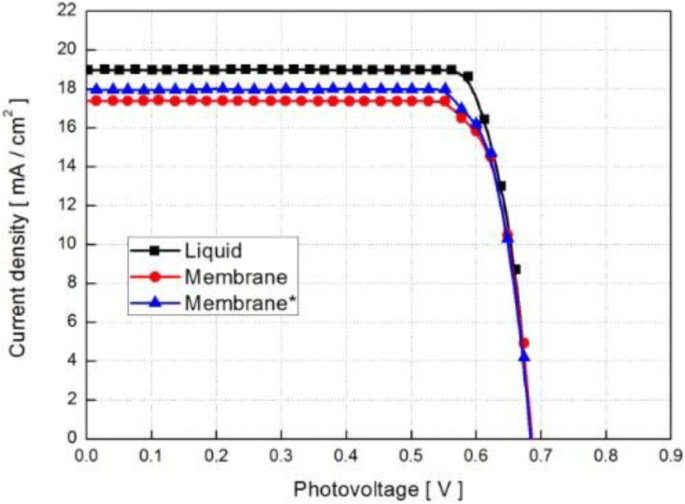
Polarization curves of DSSCs with various electrolytes under simulated AM 1.5 global sunlight (1 sun, 100 mWcm −2 ) [138]
Hole-Conducting Polymers
IPCE of 3.5% by the application of C60/polythiphene derivative in DSSCs has been achieved for pure organic solar cells [139]. However, this field is developing slowly, as its deposition by standard methods (like CBD) is difficult, because solid polymer does not penetrate the TiO2-nanoporous layer. Hence, there are only few groups applied as conducting polymers in DSSCs. Ravirajan et al. demonstrated a monochromatic efficiency of 1.4% at 440 nm by applying fluorene-thiophene copolymer [140]. Researchers are working hard so long to develop new efficient materials for electrolytes.全等人。 reported that the addition of alkylpyridinium iodide salts in electrolytes enhanced the performance of the dye-sensitized solar cells. They observed better J–V characteristics, 7.92% efficiency with V OC = 0.696 V, J SC = 17.74 mA/cm 2 , and FF = 0.641 for the cell applying EC6PI (pyridinium salts) as compared to EC3ImI (imidazolium salts), whose η = 7.46% with V OC = 0.686 V, J SC = 16.99 mA/cm 2 , and FF = 0.64 [141]. For a comparison, they added UV spectra for C6ImI and observed that the higher quantum efficiencies from the cell with EC6PI were obtained within the wide range from 460 to 800 nm. The quantum efficiencies were almost the same in the range of shorter wavelengths, may be due to the ability of C6PI to absorb more incident light than C3ImI at shorter wavelengths. Even so, the absorption coefficients for C6PI were higher than those for C6ImI over all the range, but the cell efficiencies are quite comparable (as shown in Fig. 11) [141].李等人。 developed and utilized the conjugated polymer electrolytes (CPEs) like MPF-E, MPCZ-E, MPCF-E, and MPCT-E containing quaternized ammonium iodide groups in polymer solution and gel electrolytes for DSSCs. They observed, as the polymer content in the electrolyte solution increased, the electrochemical impedance also increased for the cells based on CPE containing polymer solution electrolytes, whereas the PV performances showed the reverse trend [142]. Table 2 shows the FF and efficiencies for the DSSCs employing various dyes and mediators.
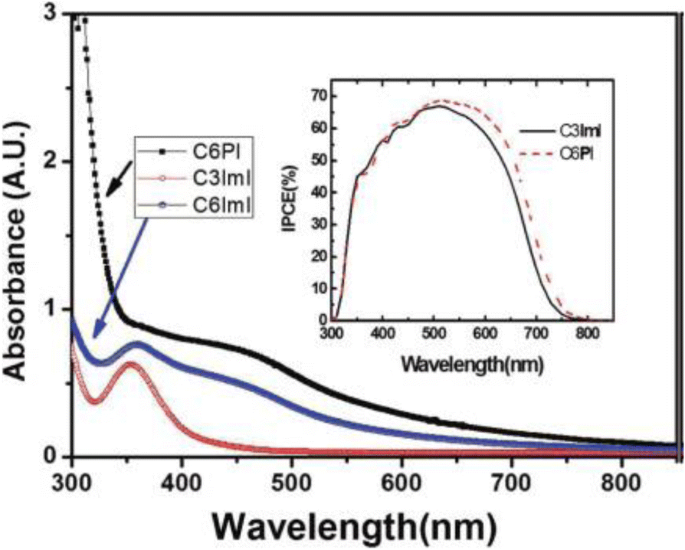
UV-vis spectroscopy selected pyridinium and imidazolium salts. The inset is the IPCE data for the cells with EC3ImI and EC6PI, which are the best cells among each series [141]
Developments in Dye Synthesis
As dyes play a key role in DSSCs, numerous inorganic and organic/metal-free dyes/natural dyes, like N3 [26], N719 [143], N749 (black dye) [144], K19 [145], CYC-B11 [146], C101 [32], K8 [147], D102 [148], SQ [149], Y123 [101], Z907 [150], Mangosteen [106], and many more have been utilized as sensitizers in DSSCs. Few of them will be discussed below briefly:
Metal (Ru) Complexes
Metal complex dyes produced from the heavy transition metals such as the complexes of ruthenium (Ru), Osmium (Os), and Iridium (Ir) have widely been used as inorganic dyes in DSSCs because of their long excited lifetime, highly efficient metal-to-ligand charge transfer spectra, and high redox properties. ML2(X)2 is the general structure of the sensitizer preferred as a dye, where M represents a metal, L is a ligand like 2,2′-bipyridyl-4,4′-dicarboxylic acid and X presents a halide, cyanide, thiocyanate, acetyl acetonate, and thiocarbamate or water substituent group [151]. Due to the thermal and chemical stability and wide absorption range from visible to NIR, the ruthenium polypyridyl complexes show best efficiencies and, thus, have been under extensive use so far.
Ru Complexes
In 1991, O’Regan and Grätzel reported the efficiency of 7.12% for the very first DSSC based on the ruthenium dye (black dye) [3]. Later, an efficiency of about 10% was reported by them using Ru-based dye (N749) which has given this topic a new sight. Most of the Ru complexes consist of Ru(II) atoms coordinated by polypyridyl ligands and thiocyanate moieties in octahedral geometery, and because of the metal to ligand charge transfer (MLCT) transitions, they exhibit moderate absorption coefficient, i.e., < 18,000 M − 1 cm − 1 . Ru (II) complexes lead the inter crossing of excited electron to the long lived triplet state and augmentation in the electron injection. Further, to improve the absorption and emission as well as electrochemical properties of Ru complexes, bipyridyl moieties can be replaced by the carboxylate polypyridine Ru dyes, phosphate Ru dyes, and poly nuclear bipyridyl Ru dyes. Table 3 and Fig. 12 show the molecular structure, the absorption spectra, and photoelectric performance for DSSCs based on different metal complex [polypyridyl (RuII)] dyes.
N3/N719/N712 Dyes
In 1993, Nazeeruddin et al. reported DSSC based on Ru-complex dye known as N3 dye {cis-di(thiocyanato)bis(2,2-bipyridine-4,4-dicarboxylate)ruthenium}, which contained one Ru center and two thiocyanate ligands (LL’) with additional carboxylate groups as anchoring sites and absorbed up to 800 nm radiations [26]. They obtained 10.3% efficiency for a system containing N3 dye and treated the dye covered film with TBP. At 518 and 380 nm wavelength, this dye attained maximum absorption spectra with respective extinction coefficients as 1.3 × 10 4 M − 1 cm − 1 and 1.33 × 10 4 M − 1 cm − 1 , 分别。 The dye has showed the 60 ns of excited state lifetime and sustained for more than 10 7 turnovers without the significant decomposition since the beginning of the illumination [26]. Further, the absorption of the dye can be extended into the red and NIR by substituting the ligands such as thiocyanate ligands and halogen ligands. For example, a device containing acetylacetonate showed η = 6.0% [152], followed by a pteridinedione complex with 3.8% efficiency [153] and a diimine dithiolate complex with 3.7% efficiency [154].
It has been investigated that during esterification, the dye gets bounded to the TiO2 chemically which results in the partial transformation of protons of the anchoring group to the surface of the TiO2. Thus, it was concluded that the photovoltaic (PV) performance of the cell gets influenced by the presence of the number of protons on the N3 photosensitizer or, in other words, the modification in protonation level of N3 (N712, N719) affects the performance of the device [155, 156], in two major aspects. Firstly, the increase in the concentration of the protons results in the positively charged TiO2 surface and the downward shift in the Fermi level of TiO2. Hence, a drop in the V OC takes place due to the positive shift of the conduction band edge induced by the surface protonation. Secondly, the electric field associated with the surface dipole enhances the absorption of the anionic Ru(II) complexes and, thus, insists the electron injection from the excited state of the dye to the conduction band of the TiO2. In 2001, Nazeeruddin et al. reported a 10.4% of efficiency for the DSSCs using a ruthenium dye, i.e., “black dye” [157], where its wide absorption band covers the entire visible range of wavelengths. Grätzel and group demonstrated the PCE of 9.3% for the monoprotonated sensitizer N3 [TBA]3 closely followed by a diprotonated sensitizer N3[TBA]2 or N719 with a conversion efficiency of 8.4% [156]. Later, Wang et al. and Chiba et al. reported a η = 10.5% [158] and η = 11.1% [159], for the devices that used black dye as a sensitizer in DSSCs.
A new dye “N719” was reported by Nazeeruddin et al. by replacing four H + counterions of N3 dye by three TBA + and one H + counterions and achieved η = 11.2% for the respective device [155]. Despite having almost the same structure to the N3 dye, the higher value of η for N719 was accredited to the change in the counterions, as they altered the speed of adsorption onto the porous TiO2 electrode, i.e., N3 is fast (3 h) whereas N719 is slow (24 h). The dye-sensitized solar cell database (DSSCDB) yields around 329 results assembled from over 250 articles when queried as “N719,” where the reported efficiencies range between 2 and 11% [160].
Recently, Shazly et al. fabricated the solid-state dye-sensitized solar cells based on Zn1-xSnxO nanocomposite photoanodes sensitized with N719 and insinuated with spiro-OMeTAD as a solid hole transport layer [161] and achieved highest efficiency of 4.3% with J SC = 12.45 mAcm − 2 , V OC = 0.740 V, and FF = 46.70. Similarly, by applying different techniques, like post treatment of photoanode, optimizing the thickness of the nc-TiO2 layer, and the antireflective filming, Grätzel group reported η = 11.3% [32] for the device containing the dyes C101 and η = 12.3% [162] for Z991 dye-based DSSCs (molecular structure shown in Fig. 13). Again, if a sensitizer does not carry even a single proton, the value expected for V OC will be high but the value for J SC becomes low. Thus, there should be an optimal amount of protonation of the sensitizer required, so that the product of both J SC and V OC can determine the conversion efficiency of the cell as a maximum. And thus, deprotonation levels of N3, N719, and N712 in solar cells were investigated, where the doubly protonated salt form of N3 or N719 showed higher PCE as compared to the other two sensitizers [143]. Figure 14 shows the effect of dye protonation on the I–V characteristics of TiO2 photoanode sensitized with different Ru dyes as N3 (4 protons), N719 (2 protons), N3[TBA]3 (1 proton), and N712 (0 protons) dyes, measured under AM 1.5 [156]. However, the main limitations of N3 sensitizers are their relatively low molar extinction coefficient and less of absorption in the red region of the visible spectrum.
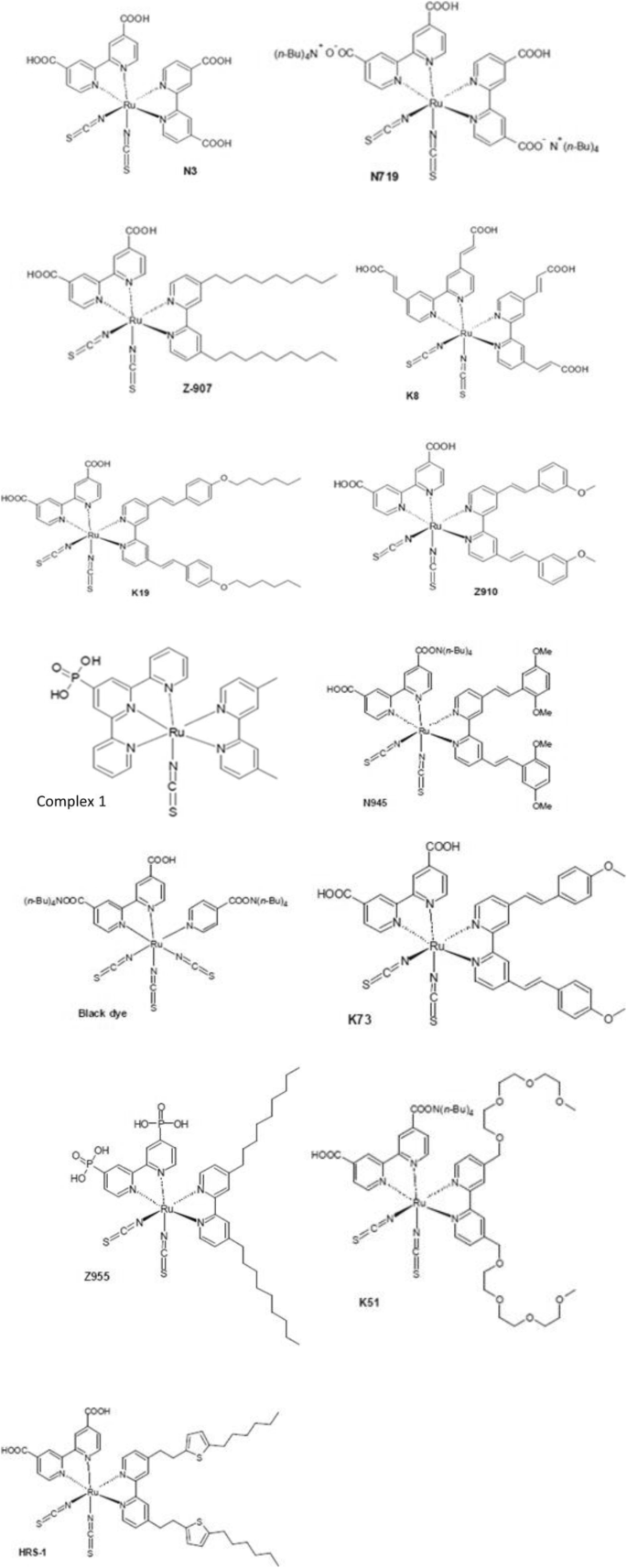
Molecular structure of Ruthenium complex based dye sensitizers
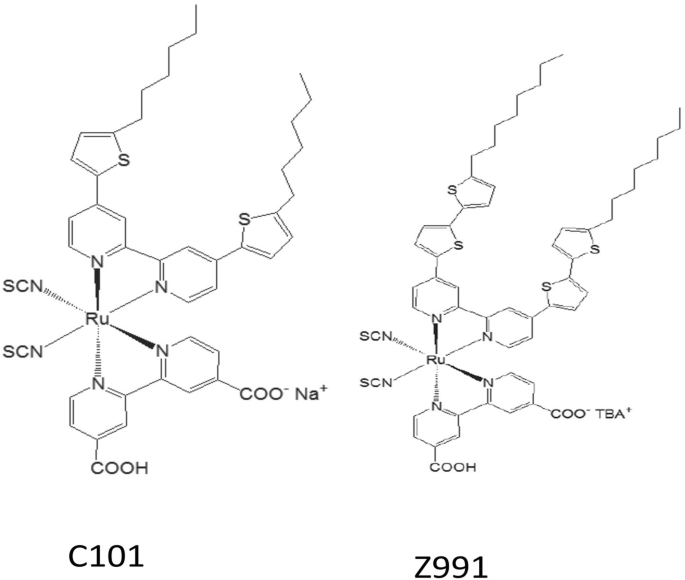
Molecular structure of C101 and Z991 sensitizers
π-System Extension (N945, Z910, K19, K73, K8, K9)
As compared to the other organic dyes, standard Ru complexes have significantly lower absorption coefficient and thus a thick layer of TiO2 was required, which results in the higher electron recombination probability. Thus, two carboxylic acid groups of N3 can be replaced by the ligands containing conjugated π-systems to enhance the absorption and the cell efficiency, simultaneously. Thus, the reason behind the π-system extension in dyes is to create sensitizers with higher molar extinction coefficients (ε ), so that the LUMO of the dye can be tuned to get directionality in the excited state and to introduce hydrophobic side chains that repel water and triiodide from the TiO2 surface. Recently, Rawashdeh et al. have demonstrated an efficiency of 0.45% by modifying the photoanode as graphene-based transparent electrode sensitized with 0.2 mM N749 dye in ethanolic solution [163].
Styryl-ligands attached to the bipyridil ring showed the utmost results. The ε = 1.69 × 10 4 M − 1 cm − 1 for the Z910 dye [164], ε = 1.82 × 10 4 M − 1 cm − 1 for the K19 dye [145], and ε = 1.89 × 10 4 M − 1 cm − 1 for the N945 dye [165] have been found, which were at least 16% more as compared to the standard N3 dye. An efficiency of 10.2% was demonstrated by Wang et al. for Z910 dye [166]. 10.8% of the efficiency was observed for the N945 dye [167] in 2007, on thick electrodes and with volatile electrolytes which was about the same as for the N3 as reference, but, when applied on thin electrodes and with non-volatile electrolytes, the observed PCE was significantly higher. At the same time, a remarkable stability at 80 °C (in darkness) and 60 °C temperature (under AM 1.5) was observed [168], and between − 0.71 V and − 0.79 V vs. normal hydrogen electrode (NHE) [145, 165, 166, 168], the excited state of these dyes has been reported and was observed sufficiently more negative than the conduction band of TiO2 (ca. − 0.1 V vs. NHE) to ensure the complete charge injection. In terms of higher molar extinction coefficient, Nazeeruddin et al. synthesized K8 and K9 dyes that showed even better results as compared to the previous ones. K8 and K9 complexes showed broad and intense absorption bands between 370 and 570 nm. In DMF solution, the K9 complex showed the maxima at 534 nm (λ max) with a ε = 14,500 M − 1 cm − 1 which was blue shifted by 22 nm compared to K8 complex which showed maxima at 556 nm with a ε = 17,400 M − 1 cm − 1 , 分别。 Thus, due to the substitution of 4, 4′-bis (carboxylvinyl)-2, 2′-bipyridine by 4,4′- dinonyl-2,2′-bipyridine, ε observed for K9 complex was ~ 20% less than that of the K8 complex. The overall PCE observed for K8 and K9 complexes were 8.46% with J SC = 18 mA/cm 2 和 V OC = 640 mV and 7.81% with J SC = 16 mA/cm 2 和 V OC = 666 mV [169], respectively. Grätzel group synthesized K19 as a second amphiphilic dye and demonstrated that K19 shows 18,200 M − 1 cm − 1 M extinction coefficient, 7.0% overall conversion efficiency and a low energy metal-to-ligand transition (MLCT) absorption band at 543 nm, which was higher than the corresponding values for the first amphiphilic dye Z907 with a molar extinction coefficient of 12,200 M − 1 cm − 1 , 6.0% overall conversion efficiency, and standard N719 dye with a molar extinction coefficient of 14,000 M − 1 cm − 1 with 6.7% overall PCE under the same fabrication and evaluation conditions. They appraised the performance of the device using N719, Z907, and K19 as sensitizers during thermal aging at 80 °C and observed a lower stability for N719 dye may be due to the desorption of the sensitizer at higher temperature; however, K19 and Z907, both retained over 92% of their initial performances under the thermal stress at 80 °C for 1000 h [145, 169].
Thiophene ligands containing Ru sensitizers also showed good efficiencies. In 2006, Yanagida et al. reported a Ru complex, by replacing a phenylvinyl group of K19 by thienylvinyl group in HRS-1 [170] and an improved stability along with respectable LHE in vis-NIR and a reversible one electron oxidation process was reported. They found a η up to 9.5% for HRS-1 (substituted thiophene derivatives). Several thiophene containing sensitizers have been developed without conjugation, such as C101 [32] and CYC-B1 [171]. After the development of C101 dye, Ru (II) thiophene compounds gained special attention as having set a new DSSC efficiency record of 11.3–11.5% and became the first sensitizer to triumph over the well-known N3 dye [32].
Amphiphilic Dyes with Alkyl Chains
Two of the four carboxylic groups of N3 dye are replaced by long alkyl chains because the ester linkage of the dye to the TiO2 was prone to hydrolyze, if water gets adsorbed on the TiO2 surface [172], thus resulting in usually lower absorption spectrum in these sensitizers due to the smaller conjugated π-system of the bipyridil-ligand. Even though the PCE offered by these sensitizers were appreciable, ranging from 7.3% for Z907 (with 9 carbon atoms) [54] to 9.6% for N621 (with 13 carbon atoms) [155] and were highly stable, Z907 sensitized DSSCs passed 1000 h at 80 °C in darkness and at 55 °C under illumination without any degradation [173]. It has been found that by coadsorption of decylphosphonic acid on the TiO2 NPs, the hydrophobicity of the surface could be even enhanced and, thus, stable cells have been demonstrated [54].
Different Anchoring Groups
Most of the sensitizers in DSSCs have carboxylic acid groups as an anchor on the surface of TiO2. But, the dye molecules get desorbed at the semiconductor surface at a pH> 9, due to the shifting of the equilibrium towards the reactant side. Thus, dyes with different anchoring groups are much needed. Again, most of the research focuses on phosphonic acid and the credit goes to its binding strength to a metal oxide surface, as the binding strength to a metal oxide surface decreases in the order, phosphonic acid> carboxylic acid> ester> acid chloride> carboxylate salts> amides [174]. Z955 is a Ru-complex containing phosphonic acid as an anchoring group and demonstrated a η = 8% accompanied by good stability under prolonged light soaking for about 1000 h at AM 1.5 and 55 °C [175]. Triethoxysilane [176] and boronic acid are some other anchoring groups. π-Extended ferrocene with varied anchoring groups (–COOH, –OH, and –CHO) has been applied as photosensitizers in DSSCs [177]. Chauhan and co-workers has synthesized and characterized two new compounds as FcCH=NC6H4COOH (1) and FcCH=NCH2CH2OH (2), where Fc = C5H4FeC5H5 and FcCHO are used as the starting material [177]. By cyclic voltammetry (CV) in dichloromethane solution and using density functional theory (DFT) calculations, they have explained the quasi-reversible redox behavior of the dyes. The redox-active ferrocenyl group exhibited a single quasi-reversible oxidation wave with E′ = 0.34, 0.44, and 0.44 V for 1, 2, and 3, respectively. In 2017, a study was carried out to inspect the influence of a cyano group in the anchoring part of the dye on its adsorption stability and the overall PV properties like electron injection ability to the surface and V OC [178]. The results indicated that the addition of the cyano group increased the stability of adsorption only when it adsorbs via CN with the surface and it decreased the photovoltaic properties when it was not involved in binding.
However, in the race of improved efficiency and efficient DSSCs, Ru (II) dyes are still an ace. The most vital reason following usage of Ru dyes in DSSCs is their extraordinary stability when being absorbed on the TiO2 surface. N749 and Z907 are the two important Ru dyes, although N749 which shows broad absorption and high efficiency, in contrast, has low absorption coefficient about ~ 7000 M − 1 cm − 1 and the stability of this dye was not so good as compared to other Ru sensitizers. PCE of 10.4% has been observed for black dye, under AM 1.5 and full sunlight [48]. It achieved sensitization over the whole visible range extending into the NIR up to 920 nm with 80% IPCE and 10.4% overall efficiency, when anchored on TiO2 nanocrystalline film. At NREL, black dye (N749)-sensitized DSSC showed efficiency of 10.4% with J SC = 20.53 mA/cm 2 , V OC = 0.721 V, and FF = 0.704, where the active area of the cell was 0.186 cm 2 [157, 179]. Nazeeruddin et al. reported a comparative study between the spectral response of the photocurrent of the two dyes, N3 and N749 [26], as shown in Fig. 15. In the vis-range, both chromophores showed very high IPCE values. The response of N749 dye was observed to be extended 100 nm further into the IR compared to that of N3. The recorded photocurrent onset was close to 920 nm and there on the IPCE rose gradually until at 700 nm it reached to a plateau of ca. 80%. From overlap integral of the curves in Fig. 8 with the AM 1.5 solar emission, it could be predicted that J SC of the N3 and black dye-sensitized cells to be 16 and 20.5 mA/cm 2 , respectively [37]. In Z907 sensitizer, one of the dicarboxy bipyridine ligands in N3 molecule was replaced by a nonyl bipyridine, which resulted in the formation of a hydrophobic environment on the device. However, the dye has set a precedent for hundreds of tris-heteroleptic Ru complexes with isothiocyanate ligands that were developed in the last 15 years, but provides efficiencies rarely comparable to N719 [180].
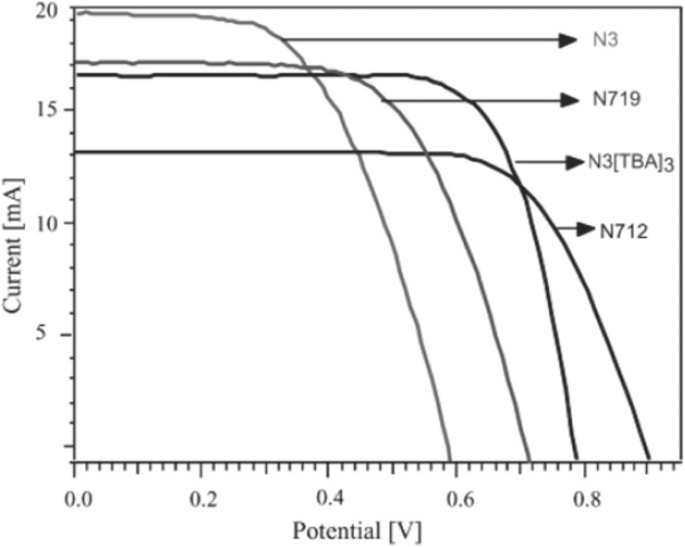
Effect of dye protonation on photocurrent-voltage characteristics of nanocrystalline TiO2 cell sensitized with N3 (4 protons), N719 (2 protons), N3[TBA]3 (1 proton), and N712 (0 protons) dyes, measured under AM 1.5 sun using 1 cm 2 TiO2 electrodes with an I − /I3 − redox couple in methoxyacetonitrile [156]
Metal-Free, Organic Dyes
Despite the capability to provide highly efficient DSSCs, the range of application of Ru dyes are limited to DSSCs, as Ru is a rare and expensive metal and, thus, not suitable for cost-effective, environmentally friendly PV systems. Therefore, development and application of new metal-free/organic dyes and natural dyes is much needed. The efficiency of DSSCs with organic dyes has been increased significantly in the last few years and an efficiency of 9% [181] was shown by Ito and co-workers. The molecular structure and the efficiency for DSSCs based on different metal-free organic dyes are shown in Table 4 and Fig. 16.
Thus, metal-free organic dyes are developing at a fast pace to overcome the limitations discussed above and especially promising is the fast learning curve, which raises hope of the further synthesis of new materials with higher stability and, thus, designing highly efficient DSSCs at much lower prices. Though the efficiencies offered by these dyes are less comparable to those by Ru dyes, their application is vast as they are potentially very cheap because of the incorporation of rare noble metals in organic dyes; thus, their cost mainly depends on the number of synthesis steps involved. Other advantages associated with organic dyes are their structure variations, low cost, simple preparation process, and environmental friendliness as compared to Ru complexes; also, the absorption coefficient of these organic dyes is typically one order of magnitude higher than Ru complexes which makes the thin TiO2 layer feasible. Thus, there is a huge demand to develop new pure organic dyes, so that the commercialization of DSSCs becomes easier.
However, there are certain limitations associated with these dyes too, as under high elevated temperatures the observed stability of the organic dyes were not as good as expected. Therefore, to get a larger photocurrent response for newly designed and developed organic dyes, it is essential to attain predominant light-harvesting abilities in the whole visible region and NIR of dyes, with a sufficiently positive HOMO than I − /I − 3 redox potential and sufficiently negative LUMO than the conduction band edge level of the TiO2 semiconductor, respectively [182, 183]. In 2008, Tian et al. fabricated DSSCs based on a novel dye (2TPA-R), containing two triphenylamine (TPA) units connected by a vinyl group and rhodanine-3-acetic acid as the electron acceptor to study the intramolecular energy transfer (EnT) and charge transfer (ICT) [184]. They found that the intramolecular EnT and ICT processes showed a positive effect on the performance of DSSCs, but the less amount of dye was adsorbed on TiO2 which may make it difficult to improve the efficiency of DSSCs [184]. An efficiency of 2.3% was attained for the DSSC used 2TPA-R dye and an imidazolium iodide electrolyte, whereas η = 2% was achieved for TPA-R dye. This improved efficiency for 2TPA-R device was possibly due to the contribution of the EnT and ICT. They studied the effect of 2TPA-R via absorption spectrum (as shown in Fig. 17) and found that the two absorption bands, i.e., λ abs at 383 nm and 485 nm obtained for 2TPA-R, are almost the same as those observed for 2TPA (λ abs at 388 nm) and TPA-R (λ abs at 476 nm) in CH2Cl2 solution (2 × 10 − 5 米)。 Thus, the study on intramolecular EnT and ICT could help in the design and synthesis of efficient organic dyes. Hence, a suitable anchoring group which can chemically bind over the TiO2 surface with a suitable structure and effective intramolecular EnT and ICT processes, is also required for synthesis.
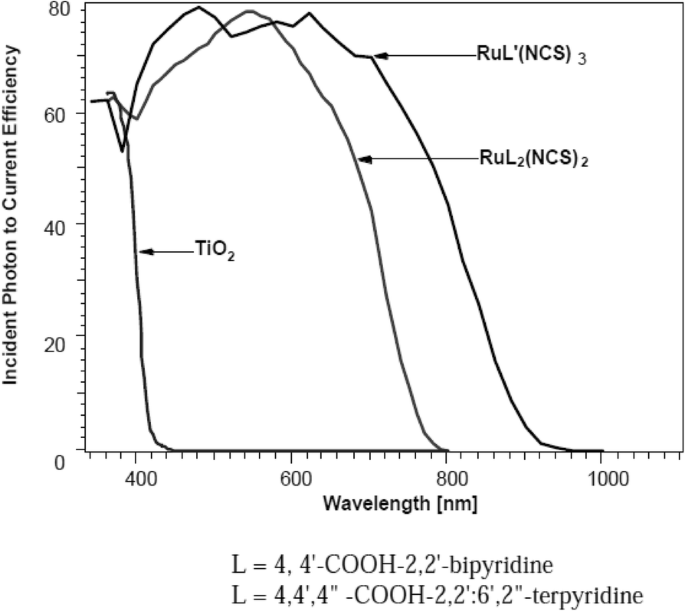
Photocurrent action spectra obtained with the N3 (ligand L) and the black dye (ligand L_) as sensitizer. The photocurrent response of bare TiO 2 films is also shown for comparison [26]
The construction of most of the organic dyes is based on the donor- acceptor (D-A)-like structure linked through a π-conjugated bridge (D–π–A) and usually has a rod-like configuration. Moieties like indoline, triarylamine, coumarin, and fluorine are employed as an electron donor unit, whereas carboxylic acid, cyanoacrylic acid, and rhodamine units are best applicable as electron acceptors to fulfill the requirement. The linking of donor and acceptor is brought about by adding π spacer such as polyene and oligothiophene [185, 186]. This type of the structure results in a higher photoinduced electron transfer from the donor to acceptor through linker (spacer) to the conduction band of the TiO2 layer, where the π-conjugation can be extended either by increasing the methine unit or by introducing aromatic rings such as benzene, thiophene, and furan or in other words by adding either electron donating or withdrawing groups, which results in the enhanced light harvesting ability of the dye, and by using different donor, linker, and acceptor groups, the photophysical properties of the organic dyes can also be tuned [187, 188]. Whereas the photophysical properties change with the expansion of π-conjugation due to the shift of the both HOMO and LUMO energy levels, thus, D–π–A structure was considered to be the most promising class of organic dyes in DSSCs as they can be easily tuned [189]. Moreover, in 2010, the encouraging efficiency up to 10.3% was reported using organic dyes [190]. Fuse et al. demonstrated a one-pot procedure to clarify the structure–property relationships of donor–π–acceptor dyes for DSSCs through rapid library synthesis [191]. Four novel organic dyes IDB-1, ISB-1, IDB-2, and ISB-2, based on 5-phenyl-iminodibenzyl (IDB) and 5-phenyliminostlbene (ISB) as electron donors and cyanoacrylic acid moiety as an electron acceptor connected with a thiophene as a π-conjugated system, were designed by Wang et al. in 2012 [192]. The highest efficiencies for the devices based on ISB-2 were observed due to the larger red shifts of 48 nm for ISB-2, indicating the more powerful electron-donating ability due to the increased linker conjugation. The absorption peaks for IDB-1, ISB-1, IDB-2, and ISB-2 were obtained at 422, 470, 467, and 498 nm in dichloromethane-diluted solution, respectively.
Tetrahydroquinolines [193, 194], pyrolidine [195], diphenylamine [196], triphenylamine (TPA) [27, 197], coumarin [198, 199], indoline [200, 201], fluorine [202], carbazole (CBZ) [203], phenothiazine (PTZ) [204, 205], phenoxazine (POZ) [206], hemicyanine dyes [207], merocyanine dyes [208], squaraine dyes [209], perylene dyes [210], anthraquinone dyes [211], boradiazaindacene (BODIPY) dyes [212], oligothiophene dyes [213], and polymeric dyes [214] are widely used in DSSCs and are still under development.贾等人。 designed quasi-solid-state DSSCs employing two efficient sensitizers FNE55 and FNE56, based on fluorinated quinoxaline moiety, i.e., 6, 7-difluoroquinoxaline moiety, and an organic dye FNE54 without fluorine was designed for comparison [215]. From the studies, it was concluded that the absorption properties of the dye enhanced bathochromically from 504 nm for FNE54 to 511 nm and 525 nm for FNE55 and FNE56 sensitizers upon the addition of fluorine into the dye. The addition of fluorine resulted in the improved electron-withdrawing ability of the quinoxaline and, thus, enhanced the push–pull interactions and narrowed the energy band gap. Due to the high polarizability, spectroscopically and electrochemically tunable properties and high chemical stability, π-conjugated oligothiophenes were well applied as spacers in DSSCs [194, 204]. To induce a bathochromic shift and augment the absorption, a number of thiophene units could be increased in the spacers, and by controlling the length of these thiophene units or chain, higher efficiencies up to two to three units can be achieved [216, 217], as the π-conjugated spacers used previously were thiophenes linked directly or through double bonds to the donor moiety [218].
As good electron injection is one of the parameters for higher efficiency in the DSSCs, cyanoacetic acid and cyanoacrylic acid are well employed as acceptor units due to their strong electron withdrawing capability.余等人。 concluded cyanoacrylic acid as a strong electron acceptor for D–π–A-based dyes because the dye incorporating cyanoacrylic acid as an electron acceptor showed the best results and, due to the maximum absorption spectrum and the highest molar excitation coefficient, the DSSC achieved η = 4.93% [219]. Wang and co-workers designed organic dyes based on thienothiophene as π conjugation unit, where they used triphenylamine as donor and cyanoacetic acid as an acceptor. They substituted different alkyl chains on the triphenylamine unit and found the best efficiency of about 7.05% for the sensitizers with longer alkoxy chains due to the longer electron lifetime [220]. Acceptors based on rhodanine-3-acetic acid were also used as an alternative, but due to the low lying molecular LUMO, the results obtained were not pleasing [221, 222].
Coumarin Dyes
Coumarin is a synthetic organic dye and is a natural compound found in many plants like tonka bean, woodruff, and bison grass (molecular structure shown in Fig. 18a). In 1996, Grätzel et al. found the efficient electron injection rates of 200 fs from C343 into the conduction band of the TiO2, where for the first time the transient studies on a coumarin dye in DSSCs were performed [223]. But the narrow absorption spectrum of C343, i.e., lack of absorption in the visible region, resulted in the lower conversion efficiency of the device. This can be altered by adding more methane groups that result in expanding the π-conjugation linkers and an increased efficiency of the DSSC [224]. Giribabu and co-workers synthesized RD-Cou sensitizers and obtained the conversion efficiency of 4.24% using liquid electrolyte, where coumarin moiety was bridged to the pyridyl groups by thiophene, which resulted in the extended π-conjugation and broadening of the metal-to-ligand charge transfer spectra [225]. They found that the absorption spectrum of RD-Cou dye was centered at 498 nm with a ɛ = 16,046 M − 1 cm − 1 . Despite the lower efficiency offered by these cells, the thermal stability of the sensitizer make its rooftop applications possible because the dye showed stability of up to 220 °C during thermal analysis.
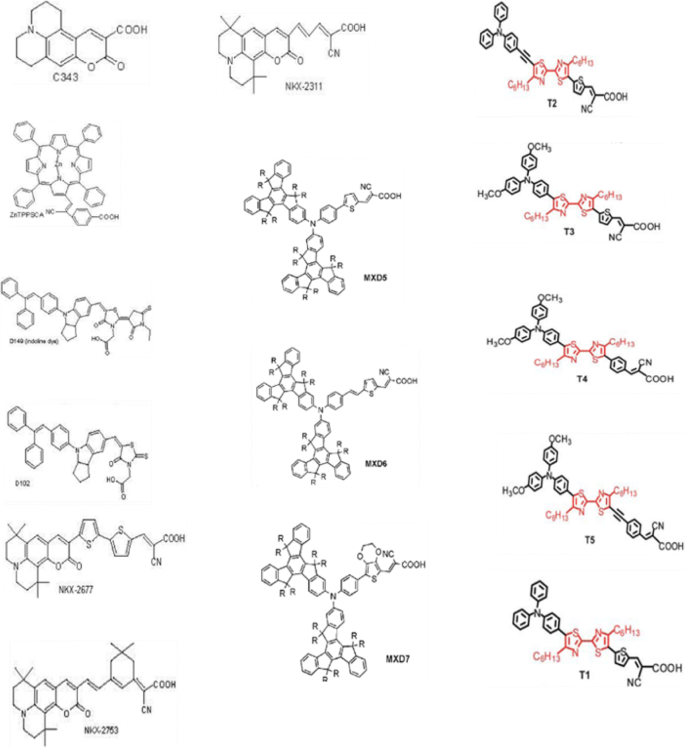
Molecular Structure of metal-free organic dyes
Indole Dyes
Indole occurs naturally as a building block in amino acid tryptophan, and in many alkaloids and dyes too (molecular structure shown in Fig. 18b). It is substituted with an electron withdrawing anchoring group on the benzene ring and an electron donating group on the nitrogen atom, and these dyes have demonstrated good potential as a sensitizer. Generally, the D–A structure of an indole dye is such that the indole moiety acts as an electron donor and is connected to a rhodanine group that acts as an electron acceptor. Also by introducing the aromatic units into the core of the indoline structure, the absorbance in the infrared (IR) region of the visible spectra as well as the absorption coefficient of the dye can be enhanced significantly [226]. An efficiency of 6.1% was demonstrated for DSSCs with D102 dye, and by optimizing the substituents, 8% of the efficiency was attained with D149 dye [200]. Another dye “D205” was synthesized by controlling the aggregation between the dye molecules, as an indoline dye with an n-octyl substituent on the rhodanine ring of D149 [227]. They investigated that n-octyl substitution increased the V OC without acknowledging the presence of CDCA too much. However, the increase in the V OC of D205 due to the CDCA was approximately 0.054 V but showed little effect on D149 with an increase of 0.006 V only. But the CDCA and n-octyl chain (D205) together improved the V OC by up to 0.710 V significantly, which was 0.066 V higher (by 10.2%) than that of D149 with CDCA.
Further in 2012, η = 9.4% was shown by Wu et al. with the observed J SC = 18 mAcm − 2 , V OC = 0.69 V, and FF = 0.78, by employing indoline as an organic dye in the respective DSSC [228]. Suzuka et al. fabricated a DSSC sensitized with indoline dyes in conjunction with the highly reactive but robust nitroxide radical molecules as redox mediator in a quasi-solid gel form of the electrolyte. They obtained an appreciable efficacy of 10.1% at 1 sun. To suppress a charge-recombination process at the dye interface, they introduced long alkyl chains, which specifically interact with the radical mediator [229]. Recently in 2017, Irgashev et al. synthesized a novel push-pull thieno[2,3-b]indole-based metal-free dyes and investigated their application in DSSCs [230]. They designed IK 3–6 dyes based on the thieno[2,3-b]indole ring system, bearing various aliphatic substituents such as the nitrogen atom as an electron-donating part, several thiophene units as a π-bridge linker, and 2-cyanoacrylic acid as the electron-accepting and anchoring group. An efficiency of 6.3% was achieved for the DSSCs employing 2-cyano-3-{5-[8-(2-ethylhexyl)-8H-thieno[2,3-b]indol-2-yl]thiophen-2-yl}acrylic acid (IK 3), under simulated AM 1.5 G irradiation (100 mWcm − 2 ), whereas the lower values of η = 1.3% and 1.4%, respectively, were shown by the dyes IK 5 and IK 6. The LUMO energy levels are more negative than the conduction edge of the TiO2 (− 3.9 eV), and their HOMO energy levels of all four dyes were found to be more positive than the I − /I3 − redox couple (− 4.9 eV), making possible regeneration of oxidized dye molecules after injection of excited electrons into TiO2 electrode (as shown in Fig. 19) [230]. The less efficiency of other dyes was contributed by the intermolecular π-stacking and aggregation processes in these dyes, proceeding on the photoanode surface.
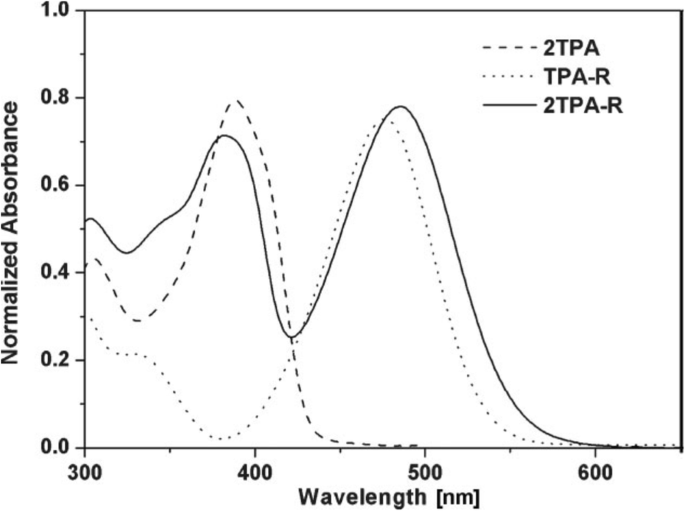
Absorption spectra of 2TPA, TPA-R, and 2TPA-R in CH2Cl2 solutions [184]
Porphyrins
Porphyrin shows strong absorption and emission in the visible region and has a long lifetime in its excited singlet state (> 1 ns), very fast electron injection rate (femtosecond range) [231], millisecond time scale electron recombination rate [232], and tunable redox potentials [13]. In 1987, the first paper was published on DSSCs based on efficient sensitization of TiO2 with porphyrins [233]. This led researchers in the direction to make efforts for the synthesis of novel porphyrin derivatives with the underlying idea to mimic nature’s photosystems I and II, so that the large molar extinction coefficient of the Soret bands and Q bands can be exploited. In 2007, a Zn-porphyrin dye-based DSSC was fabricated by Campbell et al. and has given the exceptional PCE of 7.1% [195]. Krishna and co-workers investigated the application of bulky nature phenanthroimidazole-based porphyrin sensitizers in DSSCs [234]. The group designed a novel D–π–A-based porphyrin sensitizer having strong electron-donating methyl phenanthroimidazole ring and ethynylcarboxyphenyl group at meso-position of porphyrin framework (LG11). They have attached the hexyl phenyl chains to the phenanthroimidazole moiety to reduce the unwanted loss of V OC caused by dye aggregation and charge recombination effect, thus achieving an increase in V OC to 460 and 650 mV. The energy level diagram and the absorption–emission spectra for the sensitizers (LG11-14) are shown in Fig. 20 [234].
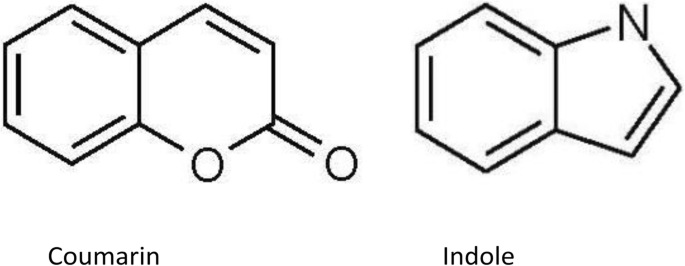
Molecular structure of a Coumarin and b indole
王等人。 have synthesized zinc porphyrins in a series bearing a phenylethynyl, naphthalenylethynyl, anthracenylethynyl, phenanthrenylethynyl, or pyrenylethynyl substituent, namely LD1, LD2, LD3a, LD3p, and LD4, as photosensitizers for DSSCs (as shown in Fig. 21). The overall efficiencies of the corresponding devices resulted as LD4 (with η = 10.06%) > LD3p > LD2 > LD3a > LD1. The higher value of η 和 V OC = 0.711 V was achieved for LD4 due to the broader and more red-shifted spectral feature; thus, the IPCE spectrum was covered broadly over the entire visible region [235]. Later for a push–pull zinc porphyrin DSSCs, changes in the structural design were carried out and structures with long alkoxyl chains enveloping the porphyrin core were built. By following the process, a η = 12.3% was achieved by Yella et al. for DSSC with cobalt as the mediator [236].
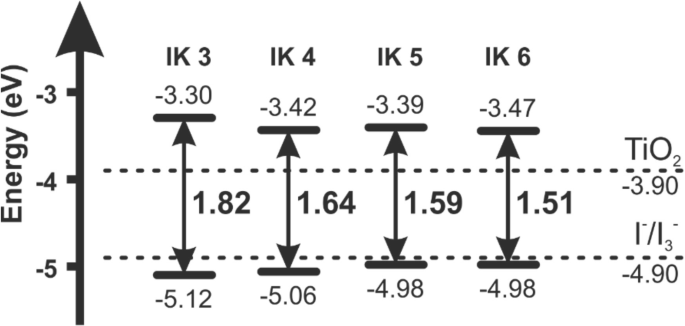
HOMO and LUMO energy level diagram of dyes IK 3–6 [230]
Giovannetti et al. investigated the free base, Cu(II) and Zn(II) complexes of the 2,7,12,17-tetrapropionic acid of 3,8,13,18-tetramethyl-21H,23H porphyrin (CPI) in solution and bounded to transparent monolayer TiO2 nanoparticle films to determine their adsorption on the TiO2 surface, to measure the adsorption kinetics and isotherms, and to use the obtained results to optimize the preparation of DSSC PVCs (photovoltaic cells) [237]. The absorption spectra study of CPI, CPIZn, and CPICu molecules onto the TiO2 surface (as shown in Fig. 22) revealed the presence of typical strong Soret and weak Q bands of porphyrin molecules in the region 400–450 nm and 500–650 nm, which were not changed with respect to the solution spectra. They observed no modification in the structural properties of the adsorbed molecules.
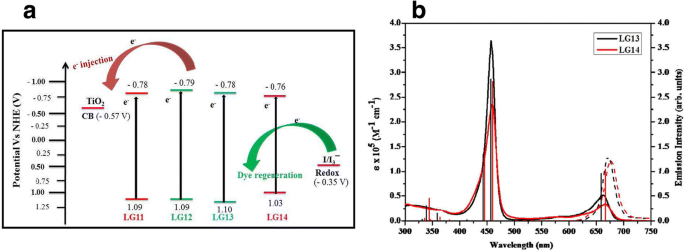
Energy level diagram of LG-11 to LG-14 porphyrins, electrolyte and TiO2 (a ) and absorption (left, solid line) and emission (right, dashed line) spectra of porphyrin sensitizers LG-13 and LG-14 in the THF solvent (b )
Triarylamine Dyes
Due to the good electron as well as transporting capability and its special propeller starburst molecular structure with a nonplanar configuration, the triarylamine group is widely applied as a HTM in various electronic devices. Triarylamine derivative distributes the π–π stacking and, thus, improves the cells performance by reducing the charge recombination, minimizing the dye aggregation and enhancing the molar extinction coefficient of the organic dye [202, 217, 238]. By the addition of alkyl chains or donating groups, the structural modification of the triarylamine derivatives could be performed [218, 220, 239]. The performance of a basic D–π–A organic dye can be improved by simply binding donor substitutions on the π-linker of the dye [240]. Thus, Prachumrak and co-workers have synthesized three new molecularly engineered D–π–A dyes, namely T2–4, comprising TPA as a donor, terthiophene containing different numbers of TPA substitutions as a π-conjugated linker and cyanoacrylic acid as an acceptor [240]. To minimize the electron recombination between redox electrolyte and the TiO2 surface as well as an increase the electron correction efficiency, the introduction of electron donating TPA substitutes on the π-linker of the D–π–A dye can play a favorable game, leading to improved V OC 和 J SC, respectively [240]. In 2006, Hagberg et al. published a paper on TPA-based D5 dye [241], where the overall PCE demonstrated for D5 dye was 5.1% in comparison with the standard N719 dye with an efficiency of 6.40% under the similar fabrication conditions. Thus, D5 appeared as an underpinning structure to design the next series of TPA derivatives.
In 2007, a series L0-L4 of TPA-based organic dyes were published by extending the conjugation in a systematic way [218]. By increasing the π conjugation, the absorption spectra and molar extinction coefficients of L0-L4 were increased. The observed IPCE spectra for L0 and L1 dyes were high, but the spectra of these dyes were not broad; as a result, lower conversion efficiencies were obtained for L0 and L1, whereas the broad absorption spectrum as well as the broad IPCE was obtained for L3 and L4 by the augmentation of linker conjugation, but the efficiencies observed were less than the L0 and L1 due to the amount of dye loading, i.e., with the increase in the size of dye there appears a decrease in the dye amount. Thus, the lower IPCE obtained for longer L3 and L4 may be accredited to unfavorable binding with the TiO2 surface. Higher efficiencies were obtained for solar cells based on L1 and L2, 2.75% and 3.08%, respectively. Baheti et al. synthesized DSSCs based on nanocrystalline anatase TiO2 and simple triarylamine-based dyes containing fluorene and biphenyl linkers [242]. They reported that the fluorene-based dyes showed better solar cell parameters than those of the biphenyl analogues. In 2011, Lu et al. reported the synthesis and photophysical/electrochemical properties of three functional triarylamine organic dyes (MXD5-7) as well as their application in dye-sensitized solar cells. They used the nonplanar structures of bishexapropyltruxeneamino as an electron donor [243] and investigated the impact of addition of chenodeoxycholic acid (CDCA) in the respective dyes, as MXD5-7 without CDCA showed lower photocurrent and efficiency as compared to the dyes MXD5-7 with 3 mM CDCA. However, the highest efficiency of 6.18% was observed for MXD7 (with 3 mM CDCA) with electron lifetime (τ ) = 63 ms, under standard global AM 1.5 solar conditions (molecular structure is given in Table 4, where R = propyl).
Using furan as a linker, different TPA-based chromophores were studied by Lin and co-workers [244]. When D5 and its furan counterpart were compared, the results were exciting, still the light harvesting abilities observed for D5 were higher (λ abs = 476 nm with ε = 45,900 M − 1 cm − 1 in ACN) than those for the furan counterpart (λ abs = 439 nm with ε = 33,000 M − 1 cm − 1 in ACN). However, the performance of the solar cells based on the furan counterpart (ɳmax = 7.36%) was better as compared to the one based on D5 (ɳmax = 6.09%) because of the faster recombination lifetimes in D5. Again, the tendency of trapping of charge from the TPA moeity was higher in thiophene than the furan. In 2016, Simon et al. reported an enhancement in the photovoltage for DSSCs that employed triarylamine-based dyes, where halogen-bonding interactions existed between a nucleophilic electrolyte species (I − ) and a photo-oxidized dye immobilized on a TiO2 surface. They found larger rate constants for dye regeneration (k reg) by the nucleophilic electrolyte species when heavier halogen substituents were positioned on the dye. Through the observations, they concluded that the halogen-bonding interactions between the dye and the electrolyte can boost the performance of DSSC [245]. However, the most efficient metal-free organic dye-based DSSC has shown PCE of 10.3% in combination with a cobalt redox shuttle, by using the phenyl dihexyloxy-substituted triphenylamine (TPA) (DHO-TPA) Y123 dye [246]. In 2018, Manfredi and group have designed di-branched dyes based on a triphenylamino (TPA) donor core with different aromatic and heteroaromatic peripheral groups bonded to TPA as auxiliary donors [247]. Thus, due to the improved strategic interface interactions between the dye sensitized titania and the liquid electrolyte, better optical properties were achieved.
Phenothiazine (PTZ) Dyes
Phenothiazine is a heterocyclic compound containing electron-rich sulfur and nitrogen heteroatoms, with a non-planar and butterfly conformation in the ground state, which can obstruct the molecular aggregation and the intermolecular excimer formation. Thus, PTZ results as a promising hole transport semiconductor in the organic devices, presenting unique electronic and optical properties [248].
Tian and co-workers investigated the effect of PTZ as an electron-donating unit in DSSCs, and because of the stronger electron donating tendency of PTZ unit than the TPA unit (0.848 and 1.04 V vs. the normal hydrogen electrode (NHE), respectively) [249], they found efficient results for the sensitizers based on PTZ rather than those based on the TPA [250]. In 2007, a new series of PTZ-based dyes as T2–1 to T2–4 was demonstrated [251]. In these dyes, PTZ unit acted as an electron donor, cyanoacrylic acid or rhodanine-3-acetic acid was used as an electron acceptor, and alkyl chains were used to increase the solubility. They found a red shift in the absorption spectra of T2–3 (η = 1.9%) and T2–4 (η = 2.4%) dyes with low IPCE values for rhodanine-3-acetic acid as an anchoring group, as compared to T2–1 (η = 5.5%) and T2–2 (η = 4.8%) dyes with cyanoacrylic acid as an anchoring group. This proved the use of the cyanoacrylic acid is more viable than a rhodanine-3-acetic acid. In 2010, Tian et al. reported modified phenothiazine (P1-P3) dyes [252] with the molecular structure containing the same acceptor and conjugation chain but different donors. Due to the presence of two methoxy groups attached to TPA, a red shift was observed in the absorption spectra of P1 as compared to P2 and P3. This resulted in an increment in the extent of electron delocalization over the whole molecule and, thus, a little red shift in the maximum absorption peak was observed.谢等人。 synthesized two novel organic dyes (PTZ-1 and PTZ-2) using electron-rich phenothiazine as electron donors and oligothiophene vinylene as conjugation spacers. They employed 13 μm transparent and 1.5 μm scattering TiO2 electrode and used an electrolyte composed of 0.6 M butylmethylimidazolium iodide (BMII), 0.03 M I2, 0.1 M GuSCN, 0.5 M 4-tert-butylpyridine in acetonitrile (TBP in ACN), and valeronitrile. They demonstrated that the (2E)-2-cyano-3-(5-(5-((E)-2-(10-(2-ethylhexyl)-10H-phenothiazin-7-yl)vinyl)thiophen-2-yl)thiophen-2-yl)acrylic acid (PTZ-1) and (2E)-3-(5-(5-(4,5-bis((E)-2-(10-(2-ethylhexyl)-10Hphenothiazin-3-yl)vinyl)thiophen-2-yl)thiophen-2-yl)thiophen-2-yl)-2cyanoacrylic acid (PTZ-2)-based DSSC showed V OC = 0.70 V, J SC = 11.69 mAcm − 2 , FF = 65.3, and η = 5.4% and V OC = 0.706 V, J SC = 7.14 mAcm − 2 , FF = 55.6, and η = 2.80% [150] under AM 1.5100 mWcm −2 illumination, respectively. The effect of hydrophilic sensitizer PTZ-TEG together with an aqueous choline chloride-based deep eutectic solvent (used as an electrolyte) has been reported [253]. In the study, glucuronic acid (GA) was used as a co-absorbent because it as has a simple structure and polar nature and is also able to better interact with hydrophilic media and components and possibly participates to the hydrogen bind interaction operated in the DES medium. PCE of 0.50% was achieved for the 1:1 dye/coabsorbent ratio.
Carbazole Dyes
It is a non-planar compound and can improve the hole transporting ability of the materials as well as avert the dye aggregate formation [235]. Due to its unique optical, electrical, and chemical properties, this compound has been applied as an active component in solar cells [254, 255]. Even with the addition of carbazole unit into the structure, the thermal stability and glassy state durability of the organic molecules were observed to be improved significantly [256, 257].田等人。 reported an efficiency of 6.02% for the DSSCs using S4 dye as a sensitizer, with an additional carbazole moiety to the outside of the donor group and found that the additional moiety facilitated the charge separation thereby decreasing the recombination rate between conduction band electrons and the oxidized sensitizer [185].
A series of MK-1, MK-2, and MK-3 dyes based on carbazole were reported by Koumura et al., where MK-1 and MK-2 have alkyl groups but MK-3 had no alkyl group. They showed that the presence of alkyl groups increased the electron lifetime and consequently V OC in MK-1 and MK-2 [203, 258, 259], and due to the absence of alkyl groups, lower electron lifetime values could be responsible for the recombination process between the conduction band electrons and dye cations in MK-3. New structured dyes, i.e., D–A–π–A-type and D–D–π–A-type organic dyes, have been developed by inserting the subordinate donor–acceptor such as 3,6-ditert-butylcarbazole-2,3-diphenylquinoxaline to facilitate electron migration, restrain dye aggregation, and improve photostability [260]. Thus, by further extending the π conjugation of the linkers, mounting the electron-donating and electron-accepting capability of donors and acceptors, and substituting long alkyl chains, more stable DSSCs with lower dye aggregation and higher efficiency can be achieved.
Phenoxazine (POZ) Dyes
Phenoxazine is a tricyclic isoster of PTZ. The PTZ and POZ units display a stronger electron donating ability than the TPA unit (0.848, 0.880, and 1.04 V vs. normal hydrogen electrode (NHE), respectively) [261]. However, DSSCs based on POZ dyes show better cell performance as compared to PTZ dye-based DSSCs [261]. In 2009, two POZ-based dyes were demonstrated by Tian et al., i.e., a simple POZ dye TH301 and triphenylamine attached to TH301, named as TH305. Due to the insertion of TPA unit in TH305, a red shift in the absorption band was seen because of the higher electron donating capability of POZ. The efficiencies obtained for TH301 and TH305 were 6.2% and 7.7%, respectively, where standard N719 sensitizer showed an efficiency of 8.0% under similar conditions [206]. Thus, in 2011, Karslson reported a series of dyes MP03, MK05, MK08, MK12, and MK13, based on POZ unit, to increase the absorption properties of the sensitizers [261]. Further, two novel metal-free dyes (DPP-I and DPP-II) with a diketopyrrolopyrrole (DPP) core were synthesized for dye-sensitized solar cells (DSSCs) by Qu et al. [262]. They demonstrated the better photovoltaic performance with a maximum monochromatic IPCE of 80% and η = 4.14% with J SC = 9.78 mAcm − 2 , V OC = 605 mV, and FF = 0.69, for the DSSC based on dye DPP-I.
Singh et al. have demonstrated nanocrystalline TiO2 dye-sensitized solar cells with PCE of 4.47% successfully designed two metal-free dyes (TPA–CN1–R2 and TPA–CN2–R1), containing triphenylamine and cyanovinylene 4-nitrophenyls as donors and carboxylic acid as an acceptor [263].
Semiconductor quantum dots (QDs) are another attractive approach to being sensitizers. These are II–VI and III–V type semiconductor particles whose size is small enough to produce quantum confinement effects. QD is a fluorescent semiconductor nanocrystal or nanoparticle typically between 10 and 100 atoms in diameter and confines the motion of electrons in conduction band, holes in valence band, or simply excitons in all three spatial directions. Thus, by changing the size of the particle, the absorption spectrum of such QDs can be easily varied. An efficiency of 7.0% has been recorded by collaborating groups from the University of Toronto and EPFL [264]. This recorded efficiency was higher than the solid-state DSSCs and lower than the DSSCs based on liquid electrolytes. A high performance QDSSC with 4.2% of PCE was demonstrated by Li et al. This cell consisted of TiO2/CuInS2-QDs/CdS/ZnS photoanode, a polysulfide electrolyte, and a CuS counter electrode [265]. In 2014, a conversion efficiency of 8.55% has been reported by Chuang et al. [266]. Recently, Saad and co-workers investigated the influence on the absorbance peak on N719 dye due to the combination between cadmium selenide (CdSe) QDs and zinc sulfide (ZnS) QDs [267]. The cyclic voltammetry (CV) of varying wt% of ZnS found that the 40 wt% of ZnS is an apposite combination for a DSSC’s photoanode and has produced the higher current. However, 50 wt% of ZnS was found to be the best concerto to increase the absorbance peak of the photoanode.
Natural dyes
New dye materials are also under extensive research, due to the intrinsic properties of Ru(II)-based dyes, and as a result to replace these rare and expensive Ru(II) complexes, the cheaper and environmentally friendly natural dyes overcome as an alternative [268].
Natural dyes provide low-cost and environmentally friendly DSSCs. There are various natural dyes containing anthocyanin [268], chlorophyll [269], flavonoid [270], carotenoid [271], etc. which have been used as sensitizers in DSSCs. Table 5 provides the general characteristics of these dyes, i.e., their availability and color range.
Molecular Structure
Anthocyanin :The molecular structure of anthocyanin is shown in Fig. 23a. In anthocyanin molecule, the carbonyl and hydroxyl groups are bound to the semiconductor (TiO2) surface, which stimulates the electron transfer from the sensitizer (anthocyanin molecules) to the conduction band of porous semiconducting (TiO2) film. Anthocyanin can absorb light and transfer that light energy by resonance energy transfers to the anthocyanin pair in the reaction center of the photosystems [272].

Molecular structures of LD porphyrins
Flavonoid :Flavonoid is an enormous compilation of natural dyes which shows a carbon framework (C6–C3–C6) or more particularly the phenylbenzopyran functionality, as shown in Fig. 23b [273]. It contains 15 carbons with two phenyl rings connected by three carbon bridges, forming a third ring, where the different colors of flavonoids depend on the degree of phenyl ring oxidation (C-ring). Its adsorption onto mesoporous TiO2 surface is quite fast by displacing an OH counter ion from the Ti sites that combines with a proton donated by the flavonoid [274].
Carotenoid :Andanthocyanin, flavonoids, and carotenoids are often found in the same organs [275]. Carotenoids are the compounds having eight isoprenoid units that are widespread in nature (as shown in Fig. 23c). Beta-carotene dye has an absorbance in wavelength zones from 415 to 508 nm, has the largest photoconductivity of 8.2 × 10 − 4 and 28.3 × 10 − 4 (Ω.m) − 1 in dark and bright conditions [276], and has great potential as energy harvesters and sensitizers for DSSCs [277].
Cholorophyll: Among six different types of chlorophyll pigments that actually exist, Chl α is the most occurring type. Its molecular structure comprises a chlorine ring with a Mg center, along with different side chains and a hydrocarbon trail, depending on the Chl type (as shown in Fig. 23d).
In 1997, antocyanins extracted from blackberries gave a conversion efficiency of 0.56% [268]. The roselle (Hibiscus sabdariffa containing anthocyanin) flowers and papaw (Carica papaya containing chlorophyll) leaves were also investigated as natural sensitizers for DSSCs. Eli et al. sensitized TiO2 photoelectrode with roselle extract (η = 0.046%) and papaw leaves (η = 0.022%), respectively and found better efficiency for roselle extract-sensitized cell because of the broader absorption of the roselle extract onto TiO2 [278]. Tannins have also been attracted as a sensitizer in DSSCs due to their photochemical stability. DSSCs using natural dyes tannins and other polyphenols (extracted from Ceylon black tea) have given photocurrents of up to 8 mAcm − 2 [168]. Haryanto et al. fabricated a DSSC using annato seeds (Bixa orellana Linn ) as a sensitizer [279]. They demonstrated V OC 和 J SC for 30 g, 40 g, and 50 g as 0.4000 V, 0.4251 V, and 0.4502 V and 0.000074 A, 0.000458 A, and 0.000857 A, respectively. The efficiencies of the fabricated solar cells using annato seeds as a sensitizer for each varying mass were 0.00799%, 0.01237%, and 0.05696%. They observed 328–515 nm wavelength range for annato seeds with the help of a UV-vis spectrometer. Hemalatha et al. reported a PCE of 0.22% for the Kerria japonica carotenoid dye-sensitized solar cells in 2012 [280].
In 2017, a paper was published on DSSCs sensitized with four natural dyes (viz. Indian jamun, plum, black currant, and berries). The cell achieved highest PCE of 0.55% and 0.53%, respectively, for anthocyanin extracts of blackcurrant and mixed berry juice [281]. Flavonoid dye extracted from Botuje (Jathopha curcas Linn ) has been used a sensitizer in DSSCs. Boyo et al. achieved η = 0.12% with the J SC = 0.69 mAcm − 2 , V OC = 0.054 V, and FF = 0.87 for the flavonoid dye-sensitized solar cell [282]. Bougainvillea and bottlebrush flower can also be used as a sensitizer in DSSCs because both of them show a good absorption level in the range of 400 to 600 nm as a sensitizer, with peak absorption at 520 nm for bougainvillea and 510 nm for bottlebrush flower [283]. A study of color stability of anthocyanin (mangosteen pericarp) with co-pigmentation method has been conducted by Munawaroh et al. They have found higher color retention for anthocyanin-malic acid and anthocyanin-ascorbic acid than that of pure anthocyanin [284]. Thus, the addition of ascorbic acid and malic acid as a co-pigment can be performed to protect the color retention of anthocyanin (mangosteen pericarp) from the degradation process. 我 –V characteristics of DSSCs employing different natural dyes are shown in Table 6.
Organic Complexes of Other Metals
Os, Fe and Pt complexes [285, 286, 287] are considered to be some other promising materials in DSSCs. Besides the fact that Os complexes are highly toxic, they are applied as a sensitizer in DSSCs due to its intense absorption (α811nm = 1.5 × 103 M− 1 cm− 1) and for the utilization of spin forbidden singlet-triplet MLCT transition in the NIR. Higher IPCE values were obtained in this spectral region; however, the overall conversion efficiency was only 50% of a standard Ru dye. Pt complexes have given modest efficiencies of ca. 0.64% [286] a and iron complexes, which are very interesting due to the vast abundance of the metal and its non-toxicity; the solvatochromism of complexes like [FeIIL2(CN)2] can be used to adjust their ground and excited state potentials and increase the driving force for electron injection into the semiconductor conduction band or for regeneration of the oxidized dye by the electrolyte couple [287].
Thus, a number of metal dyes, metal-free organic dyes, and natural dyes have been synthesized till today. Many other dyes like K51 [288], K60 [289], K68 [290]; D5, D6 (containing oligophenylenevinylene π-conjugated backbones, each with one N ,N -dibutylamino moiety) [291]; K77 [292]; SJW-E1 [293]; S8 [294]; JK91 and JK92 [295]; CBTR, CfBTR, CiPoR, CifPoR, and CifPR [296, 297]; Complexes A1, A2, and A3 [298]; T18 [299]; A597 [300]; YS-1–YS-5 [301]; YE05 [302]; and TFRS-1–3 [303] were developed and applied as sensitizers in DSSCs.
Latest Approaches and Trends
However, a different trend to optimize the performance of the DSSCs has been started by adding the energy relay dyes (ERDs) to the electrolyte [57, 304]; inserting phosphorescence or luminescent chromophores, such as applying rare-earth doped oxides [58,59,60] into the DSSC; and coating a luminescent layer on the glass of the photoanode [61, 62]. In the process of adding the ERDs to the electrolyte or to the HTM, some highly luminescent fluorophores have to be chosen. The main role of ERD molecules in DSSCs is to absorb the light that is not in the primary absorption spectrum range of the sensitizing dye and then transfer the energy non-radiatively to the sensitizing dyes by the fluorescence (Forster) resonance energy transfer (FRET) effect [305]. An improvement in the external quantum efficiency of 5 to 10% in the spectrum range from 400 to 500 nm has been demonstrated by Siegers and colleagues [306]. Recently, Lin et al. reported the doping of 1,8-naphthalimide (N-Bu) derivative fluorophore directly into a TiO2 mesoporous film with N719 for application in DSSCs [307], in which the N-Bu functioned as the FRET donor and transferred the energy via spectral down-conversion to the N719 molecules (FRET acceptor). An improvement of the PCE from 7.63 to 8.13% under 1 sun (AM 1.5) illumination was attained by the cell. Similarly, Prathiwi et al. fabricated a DSSC by adding a synthetic dye into the natural dye containing anthocyanin (from red cabbage) in 2017 [308]. They prepared two different dyes at different volumes, i.e., anthocyanin dye at a volume of 10 ml and combination dyes at a volume of 8 ml (anthocyanin):2 ml (N719 synthetic dye), respectively. They observed an enhancement in conversion efficiency up to 125%, because individually the anthocyanin dye achieved a conversion efficiency of 0.024% whereas for the combination dye 0.054% conversion efficiency was achieved. This enhancement was considered due to the higher light absorption. Thus, greater photon absorption took place and the electrons in excited state were also increased to enhance the photocurrent. Thus, cocktail dyes are also developing as a new trend in DSSCs.张等人。 achieved a η = 1.47% when chlorophyll dye (from wormwood) and anthocyanin dye (from purple cabbage) as natural dyes were mixed together at volume ratio of 1:1 [309], whereas the individual dyes showed lower conversion efficiencies. Puspitasari et al. fabricated different DSSCs by mixing the three different natural dyes as turmeric, mangosteen, and chlorophyll. The highest efficiency of 0.0566% was attained for the mixture of the three dyes, where the absorbance peak of the mixed dyes was observed at 300 nm and 432 nm [106]. Similarly, Lim and co-workers have achieved a 0.085% of efficiency when mixing the chlorophyll and xanthophyll dyes together [310]. In 2018, Konno et al. studied the PV characteristics of DSSCs by mixing different dyes and observed highest ɳ = 3.03% for the combination dye “D358 + D131,” respectively [311]. Figure 24 shows the IPCE of mixed pigments and single pigments.
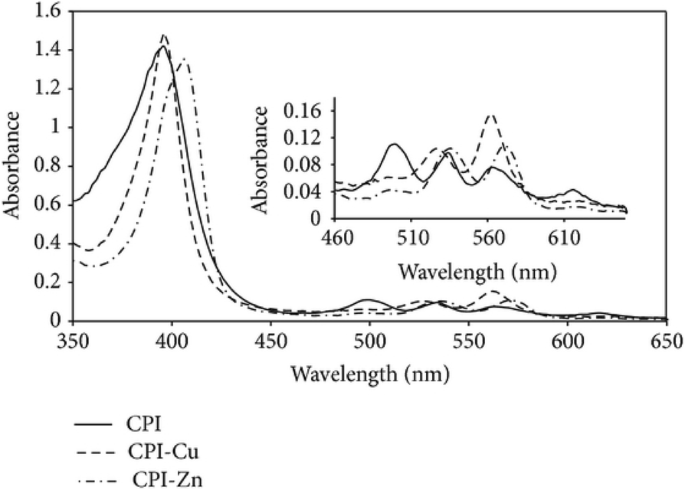
UV-vis spectra and in insert Q-band magnification for CPI, CPICu, and CPIZn incorporated into the TiO2 films [237]
An approach used to enhance the performance of DSSCs is plasmonic effect. Surface plasmon resonance (SPR) is resonant oscillation of conduction electrons at the interface between negative and positive permittivity material stimulated by incident light. In 2013, Gangishetty and co-workers synthesized core-shell NPs comprising a triangular nanoprism core and a silica shell of variable thickness. SPR band centered at ~ 730 nm was observed for the nanoprism Ag particles, which overlapped with the edge of the N719 absorption spectrum very well. They found the incorporation of the nanoprism Ag particles into the photoanode of the DSSCs yielded a 32% increase in the overall PCE [312]. Hossain et al. used the phenomenon of plasmonic with different amounts of silver nanoparticles (Ag NPs) coated with a SiO2 layer prepared as core shell Ag@SiO2 nanoparticles (Ag@SiO2 NPs) and studied the effect of SiO2-encapsulated Ag nanoparticles in DSSCs. They found the highest PCE of 6.16% for the photoanode incorporated 3 wt% Ag@SiO2; the optimal PCE was 43.25% higher than that of a 0 wt% Ag@SiO2 NP photoanode [313]. However, a simultaneous decrease in the efficiency with further increases in the wt% ratio, i.e., for 4 wt% Ag@SiO2 and 5 wt% Ag@SiO2, was observed. This decrease for the excess amounts of Ag@SiO2 NPs was attributed to three reasons:(i) reduction in the effective surface area of the films, (ii) absorption of less amount of the dye, and (iii) an increase in the charge-carrier recombination [314]. After analyzing the nyquist plots (as shown in Fig. 25), they have found a decreased diameter of Z2 monotonically as the Ag@SiO2 NP content increased to 3 wt% and R2 decreased from 10.4 to 6.64 Ω for the conventional DSSC to the 3 wt% Ag@SiO2 NPs containing DSSC. Jun et al. used quantum-sized gold NPs to create plasmonic effects in DSSCs [315]. They fabricated the TiO2 photoanode by incorporating the Au nanoparticles (Au NPs) with an average diameter of 5 nm into the commercial TiO2 powder (average diameter 25 nm) and used N749 black dye as a sensitizer. Thus, due to the SPR effect, the efficiency for the DSSC (incorporating Au NPs) was enhanced by about 50% compared to that without Au nanoparticles. Effect of incorporating green-synthesized Ag NPs into the TiO2 photoanode has been investigated in 2017 [316]. Uniform Ag NPs synthesized by treating silver ions with Peltophorum pterocarpum flower extract at room temperature showed the Ag NPs as polycrystalline in nature with face centered cubic lattice with an approximate size in the range of 20–50 nm [316]. The PCE of the device was improved from 2.83 to 3.62% with increment around 28% after incorporation of the 2 wt% of the Ag NPs due to the plasmonic effect of the modified electrode. Bakr et al. have fabricated Z907 dye-sensitized solar cell using gold nanoparticles prepared by pulsed Nd:YAG laser ablation in ethanol at wavelength of 1064 nm [63]. The addition of synthesized Au NPs to the Z907 dye increased the absorption of the Z907 dye, thus achieving ɳ = 1.284% for the cell without Au NPs and 2.357% for the cell incorporating the Au NPs. Recently, in 2018, a novel 3-D transparent photoanode and scattering center design was applied as to increase the energy conversion efficiency from 6.3 to 7.2% of the device [317] because the plasmonics plays an important role in the absorption of light and thus, the application is developing at a very fast pace and grabbing a lot of attention worldwide in the last few years. Recently, a study on incorporation of Mn 2+ into CdSe quantum dots was carried out by Zhang and group [318]. An improved efficiency from 3.4% (CdS/CdSe) to 4.9% (CdS/Mn-CdSe) was achieved for the device upon the addition of Mn 2+ into CdSe because when Mn 2+ is doped into the CdSe (as shown in Fig. 26), the QDs on the surface of the film became compact and the voids among the particles were small, thus reducing the recombination of photogenerated electrons. Also with the loading of Mn 2+ into the CdSe, the size of the QD clusters was increased. However, in QDSCs (quantum dot-sensitized solar cells), there is an inefficient transfer of electrons through the mesoporous semi-conductor layer [319], because their application on a commercial level is still far off. Thus, Surana et al. reported the assembling of CdSe QDs, tuned for photon trapping at different wavelengths in order to achieve an optimum band alignment for better charge transfer in QDSC [319]. TiO2 hollow spheres (THSs) synthesized by the sacrifice template method was reported as a scattering layer for a bi-layered photoanode for DSSCs by Zhang and co-workers [320]. They used the mixture of multi-walled carbon nanotubes with P25 as an under layer and THSs as an overlayer for the photoanode which showed good light scattering ability. The cross-sectional FESEM images revealed the disordered mecroporous network for the scattering layer containing THSs which was supposed to be responsible for the enhanced light absorption and the transfer of electrolyte. Thus, ɳ = 5.13% was achieved for P25/MWNTs-THSs, whereas 4.49% of efficiency was reported for a pure P25 photoanode-based DSSC. Also, the electron lifetime (τ e) estimated for pure P25 by Bode phase plots of EIS spectra was 5.49 ms; however, 7.96 ms was shown for P25/MWNTs-THSs.
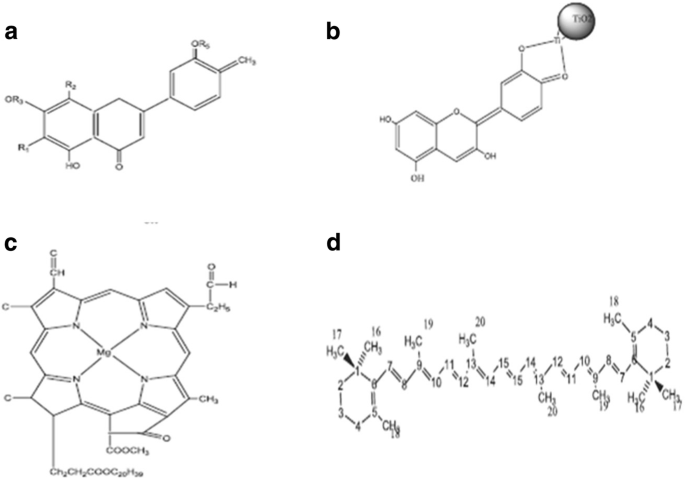
Chemical structures of a anthocyanin, b flavonoid, c β,β-carotene, and d chlorophyll
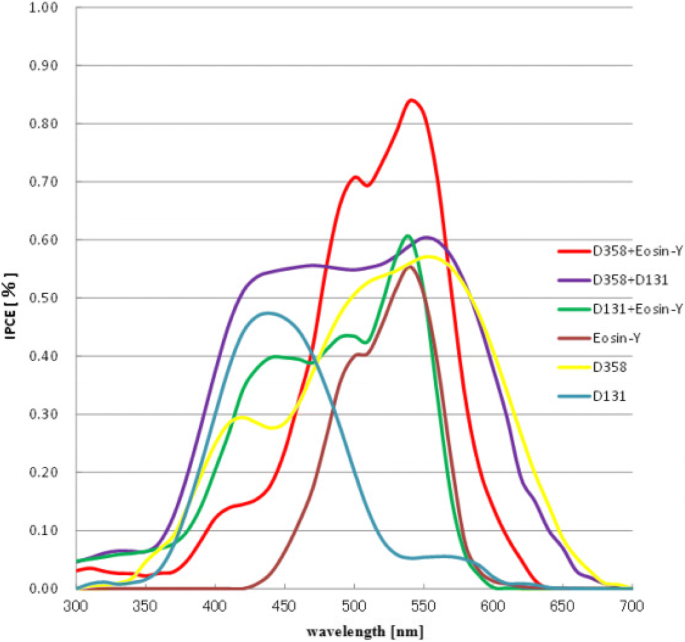
IPCE of mixed pigment and single pigments, where single pigment were Eosin Y, D131, and D358 and mixed pigments were D358 and Eosin Y; D358 and D131; D131 and Eosin Y [311]
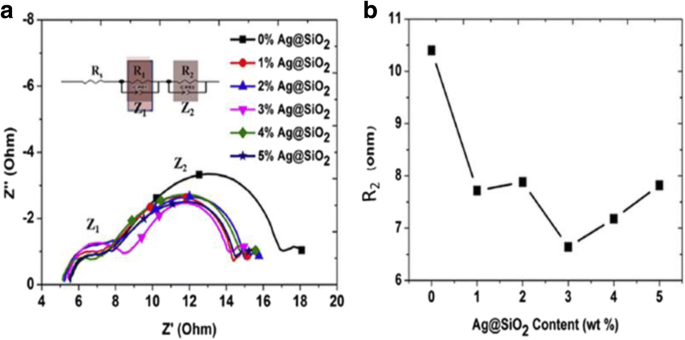
一 Nyquist plots obtained from the EIS of DSSCs with varying Ag@SiO2 content (inset shows the equivalent circuit). b R2 ohm with respect to the Ag@SiO2 NPs content [313]

a 的 SEM 图像 CdS/CdSe and b CdS/Mn:CdSe QD sensitization on TiO 2 表面。 c TEM image of CdS/Mn:CdSe QDs [318]
John and group reported the synthesis and application of ZnO-doped TiO2 nanotube/ZnO nanoflake heterostructure as a photoanode in DSSCs for the first time in 2016 [321]. They used different characterization techniques to investigate the layered structure of the novel nanostructure. The Rutherford backscattering spectroscopy revealed that during the doping process, a small percentage of Zn was doped into TONT in addition to the formation of ZnO nanoflakes on the top, which led to a preferential orientation of the nanocrystallites in the tube on annealing. Back in 2017, Zhang et al. reported paper on low-dimensional halide perovskite and their applications in optoelectronics due to the ~ 100% of photoluminescence quantum yields of perovskite quantum dots [322]. The main emphasis of their paper was on the study of halide perovskites and their versatile application, i.e., in optoelectronics in spite of PV applications only. The main role of perovskite nanoparticles in solar cells is being applied as sensitizers. Similarly, in the queue of developing highly efficient DSSCs, Chiang and co-workers fabricated DSSCs based on PtCoFe nanowires with rich {111} facets exhibiting superior I − 3 reduction activity as a counter electrode, which surpassed the previous PCE record of the DSSCs using Ru(II)-based dyes [323]. Recently, in accordance with enhancing the charge collection efficiencies (η coll) as well as PCE of DSSCs, Kunzmann et al. reported a new strategy of fabricating low-temperature (lt)-sintered DSSC and demonstrated the highest efficacy reported for lt-DSSC to date [324]. They have integrated TiO2-Ru(II) complex (TiO2_Ru_IS)-based hybrid NPs into the photoelectrode. Due to a better charge transport and a reduced electron recombination, devices with single-layer photoelectrodes featuring blends of P25 and TiO2_Ru_IS give rise to a 60% η coll relative to a 46% η coll for devices with P25-based photoelectrodes. Further, for usage of a multilayered photoelectrode architecture with a top layer based on TiO2_Ru_IS only, devices with an even higher η coll (74%) featuring a η = 8.75% and stabilities of 600 h were shown. The two major rewards obtained for such devices were the dye stability due to its amalgamation into the TiO2 anatase network and, secondly, the enhanced charge collection yield due to its significant resistance towards electron recombination with electrolytes.
Conclusions
The main aim of this study was to put a comprehensive review on new materials for photoanodes, counter electrodes, electrolytes, and sensitizers as to provide low-cost, flexible, environmentally sustainable, and easy to synthesize DSSCs. However, a brief explanation has been given to greater understand the working and components of DSSCs. One of the important emphases in this article has been made to establish a relation between the photosensitizer structure, the interfacial charge transfer reactions, and the device performance which are essential to know as to develop new metal and metal-free organic dyes. In terms of low stability offered by DSSCs, two major issues, i.e., low intrinsic stability and the sealing of the electrolytes (extrinsic stability), have been undertaken in this study. To fulfill huge demand of electricity and power, we have two best possible solutions:this demand should be compensated either by the nuclear fission or by the sun. Even so, the nuclear fission predicted to be the best alternative has great environmental issues as well as a problems associated with its waste disposal. Thus, the second alternative is better to follow. DSSCs are developed as a cheap alternative but the efficiency offered by DSSCs in the field is not sufficient. Thus, we have to do a wide research on all possible aspects of DSSCs. We proposed to develop DSCCs based on different electrodes viz. graphene, nanowires, nanotubes, and quantum dots; new photosensitizers based on metal complexes of Ru or Os/organic metal-free complexes/natural dyes; and new electrolytes based on imidazolium salts/pyridinium salts/conjugated polymers, gel electrolytes, polymer electrolytes, and water-based electrolytes. In summary, so far, extensive studies have been carried out addressing individual challenges associated with working electrode, dye, and electrolytes separately; hence, a comprehensive approach needs to be used where all these issues should be addressed together by choosing appropriate conditions of electrolyte (both in choice of material and structure), optimum dye, and the most stable electrolyte which provides better electron transportation capability.
In terms of their commercial application, a DSSC needs to be sustainable for> 25 years in building-integrated modules to avoid commotion of the building environment for repair or replacement and a lifespan of 5 years is sufficient for portable electronic chargers integrated into apparel and accessories [325]. However, DSSCs are being quite bulky due to their sandwiched glass structure, but the flexible DSSCs (discussed elsewhere) that can be processed using roll-to-roll methods may came as an alternative but then has to compromise with the shorter lifespan. Although the stability and lifetime of a DSSC most probably depend on the encapsulation and sealing as discussed above. Apart from the usage of expensive glass substrates in the case of modules and panels, one of the biggest hurdles is to manufacture glass that is flat at the 10 μm length scale over areas much larger than 30 × 30 cm 2 [326] and the humidity. Another challenge is to choose which metal interconnects in the cells that are more or less corroded to the electrolyte, and high degree of control over cell-to-cell reproducibility is required to achieve same current and/or voltage for all the cells in the module. If the abovementioned challenges would be overcome, then there is no roadblock for the commercial applications of DSSCs, which has been restricted up to an amicable extent. G24i has introduced a DSC module production of 25 MW capacity in 2007 in Cardiff, Wales (UK), with extension plans up to 200 MW by the end of 2008 (http://www. g24i. com), and afterwards, many DSSC demonstration modules are now available. However, the maximum outdoor aging test of DSSCs is reported for 2.5 years up to now [327].
缩写
- ACN:
-
Acetonitrile
- Ag NPs:
-
Silver nanoparticles
- AM 1.5:
-
Air mass 1.5
- Au NPs:
-
金纳米粒子
- BODIPY:
-
Boradiazaindacene
- BPI:
-
4,5-Bis(4-methoxyphenyl)-1H-imidazole
- C:
-
Carbon
- CBZ:
-
Carbazole
- CDCA:
-
Chenodeoxycholic acid
- CdSe:
-
Cadmium selenide
- CNF:
-
碳纳米纤维
- CNT:
-
碳纳米管
- CPEs:
-
Conjugated polymer electrolytes
- CuBr:
-
Copper bromide
- CuI:
-
Copper iodide
- CuSCN:
-
Copper thiocyanate
- 简历:
-
循环伏安法
- DPP:
-
Diketopyrrolopyrrole
- DSSCDB:
-
Dye-sensitized solar cell database
- DSSCs:
-
Dye-sensitized solar cells
- EC:
-
碳酸亚乙酯
- EIS:
-
Electron impedance spectroscopy
- EPFL:
-
Ecole Polytechnique Fédèrale de Lausanne
- ERDs:
-
Energy relay dyes
- FF:
-
填充因子
- 烦恼:
-
Fluorescence (Forster) resonance energy transfer
- FTO:
-
掺氟氧化锡
- GA:
-
Glucuronic acid
- GBL:
-
γ-Butyrolactone
- GuSCN:
-
Guanidinium thiocyanate
- HfO2 :
-
Hafnium oxide
- HOMO:
-
最高占据分子轨道
- HTMs:
-
Hole transport materials
- IL:
-
Ionic liquid
- IMVS:
-
Intensity-modulated photovoltage spectroscopy
- IPCE:
-
Incident photon to current conversion efficiency
- Ir:
-
Iridium
- ITO:
-
Indium-doped tin oxide
- J SC :
-
Short circuit current
- LCs:
-
Liquid crystals
- LHE:
-
Light harvesting efficiency
- LUMO:
-
最低未占分子轨道
- MePN:
-
3-Methoxypropionitrile
- MLCT:
-
Metal to ligand charge transfer
- nc:
-
Nanocrystalline
- NHE:
-
普通氢电极
- 近红外:
-
Near-infrared region
- NMBI:
-
N -Methylbenzimidazole
- NMP:
-
N -Methylpyrrolidine
- NP:
-
纳米粒子
- Os:
-
Osmium
- PANI:
-
聚苯胺
- PC:
-
Propylene carbonate
- PCE:
-
电源转换效率
- PEO:
-
聚(环氧乙烷)
- PET:
-
聚对苯二甲酸乙二醇酯
- P max :
-
Maximum power output
- POZ:
-
Phenoxazine
- Pt:
-
Platinum
- PTZ:
-
Phenothiazine
- PV:
-
Photovoltaic
- 量子点:
-
量子点
- QSSE:
-
Quasi-solid-state electrolyte
- RT:
-
Room temperature
- Ru:
-
Ruthenium
- SCE:
-
饱和甘汞电极
- SCs:
-
Solar cells
- SPR:
-
表面等离子体共振
- SSE:
-
Solid-state electrolyte
- 待定:
-
4-Tert-butylpyridine
- TCO:
-
Transparent conducting oxide
- TiO2 :
-
Titanium dioxide
- TPA:
-
Triphenylamine
- UV-vis:
-
紫外可见
- V 超话:
-
Open circuit voltage
- WE:
-
Working electrode
- 氧化锌:
-
氧化锌
- ZnS:
-
硫化锌
- η :
-
Efficiency
纳米材料


